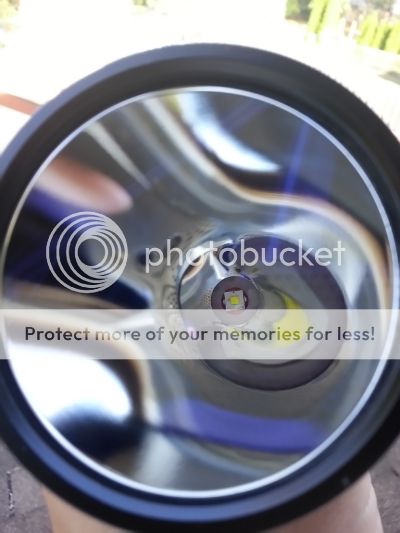Reviewer's Note: This is a review of a custom modified light from the CPF modder Vinh Nguyen (V54). For more information on Vinh's lights, please check out his subforum of the CPF Custom Flashlight Builders and Modders forum.
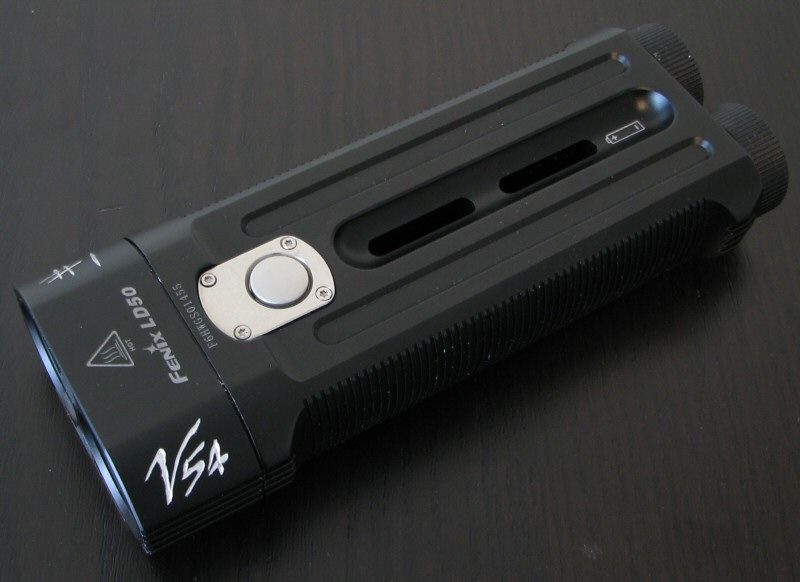
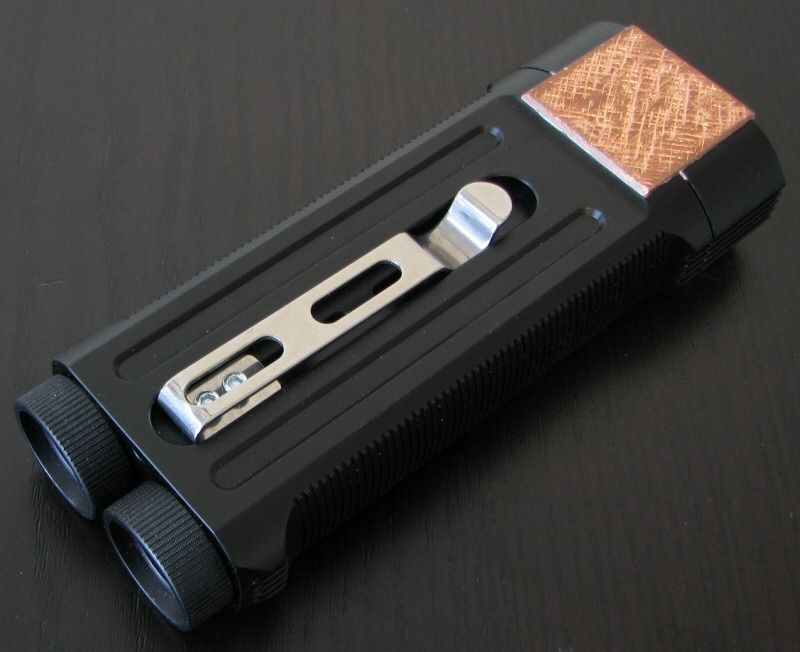
The Fenix LD50 is one of the recent lights to have undergone Vinh's transformations. My review sample of the LD50vn features Vinh's PDTc ("premium dedome tint – cool white"), although versions with just the circuit modification are also available. For more information about the LD50vn, please see Vinh's LD50vn discussion thread here on CPF. For more information on the PDT, please see this thread from Vinh.
I have not reviewed the stock LD50, but will compare the LD50vn to other dual-cell and/or dual-emitter lights in my collection.
Stock Fenix LD50 Reported Specifications:
(note: as always, these are simply what the manufacturer provides – scroll down to see my actual testing results).
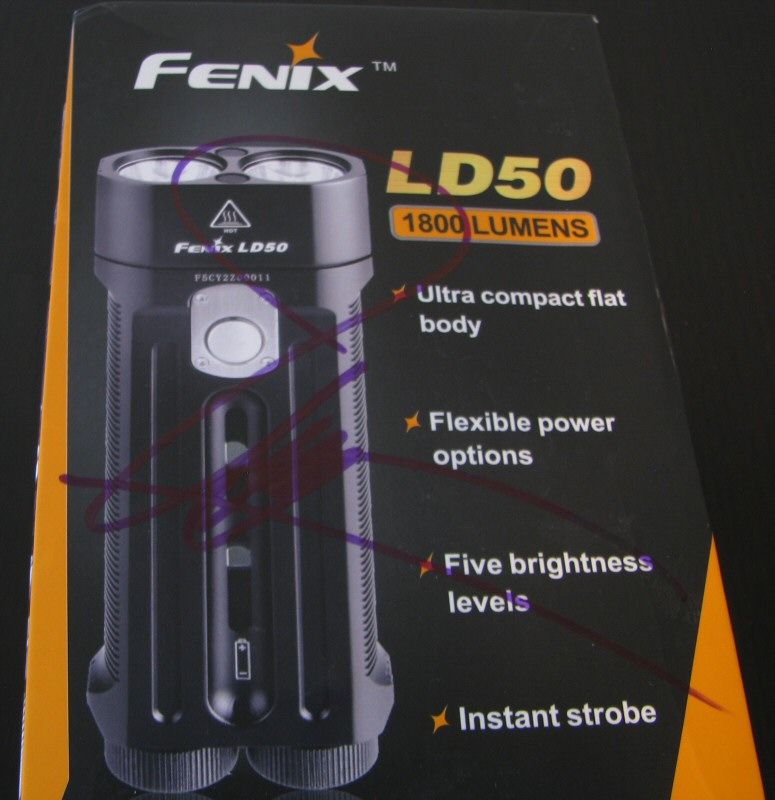
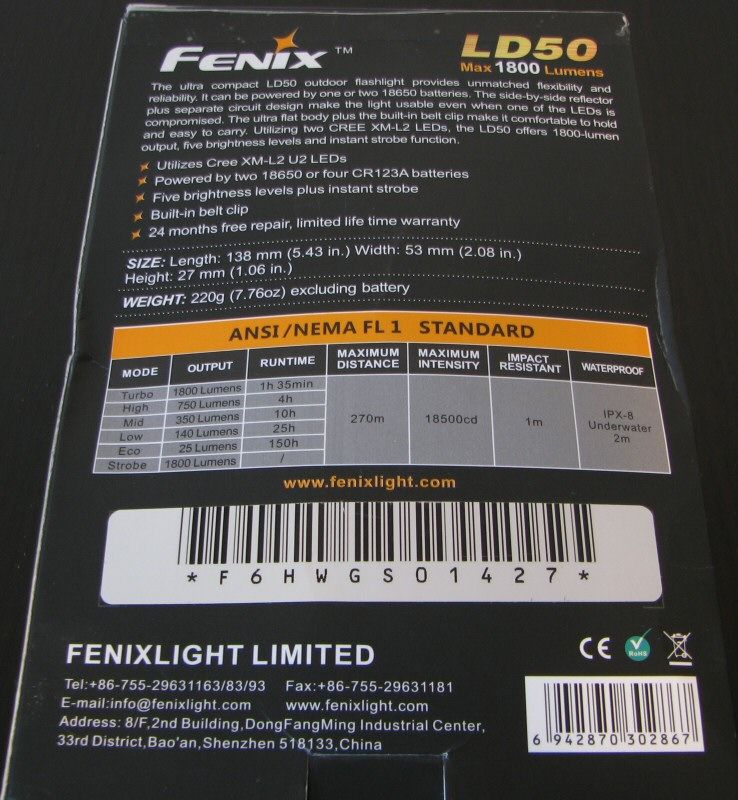
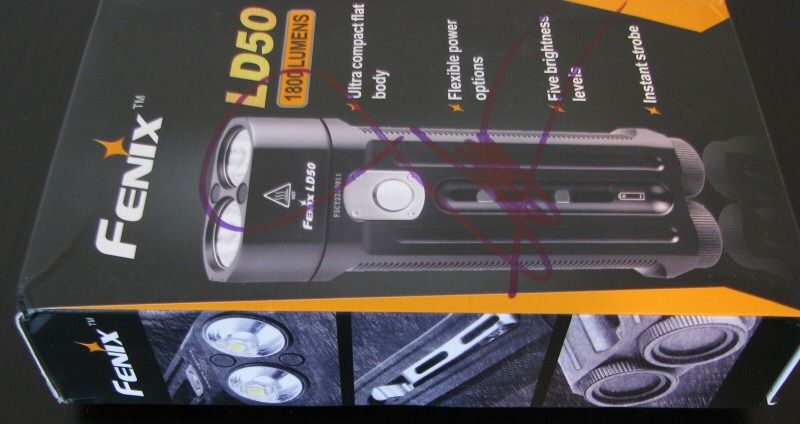
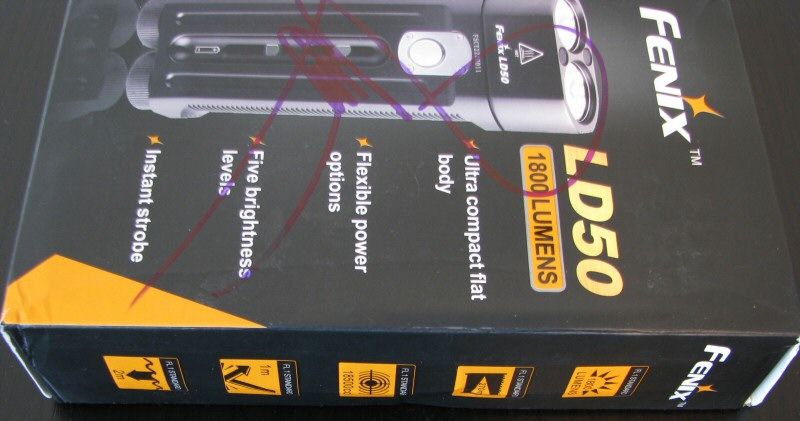
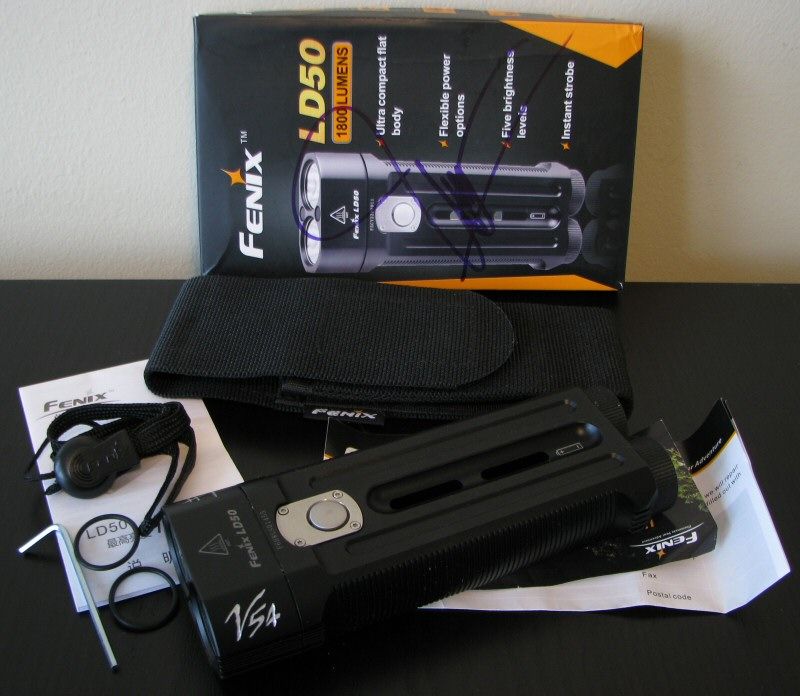
As per usual for a V54-modded light, packaging of the LD50vn is the standard stock retail packaging of the LD50 (signed by Vinh). Printed on the sides and back are the key characteristics of the stock Fenix light. Inside, included with the light are spare O-rings, basic wrist lanyard, allen key (to remove the attached pocket clip), warranty card and manual.
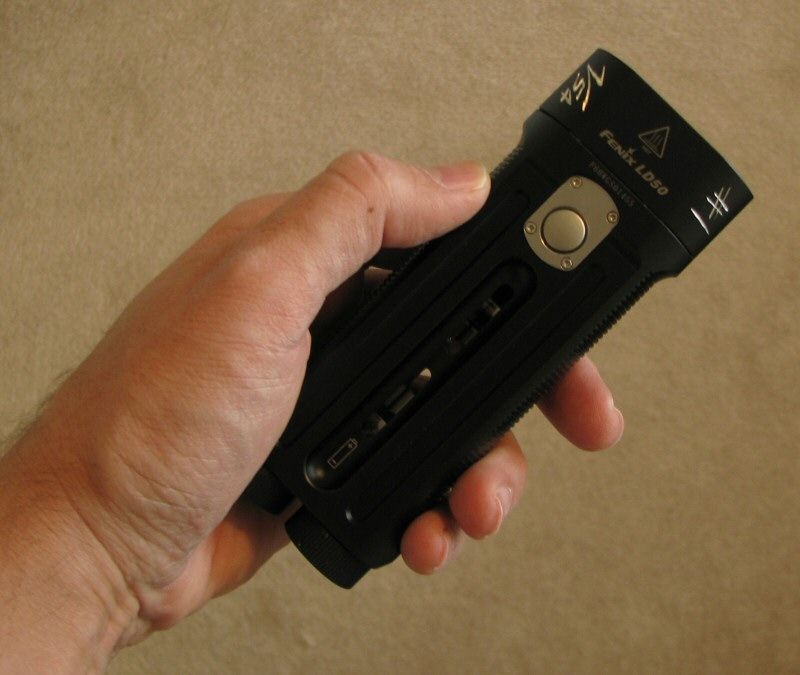
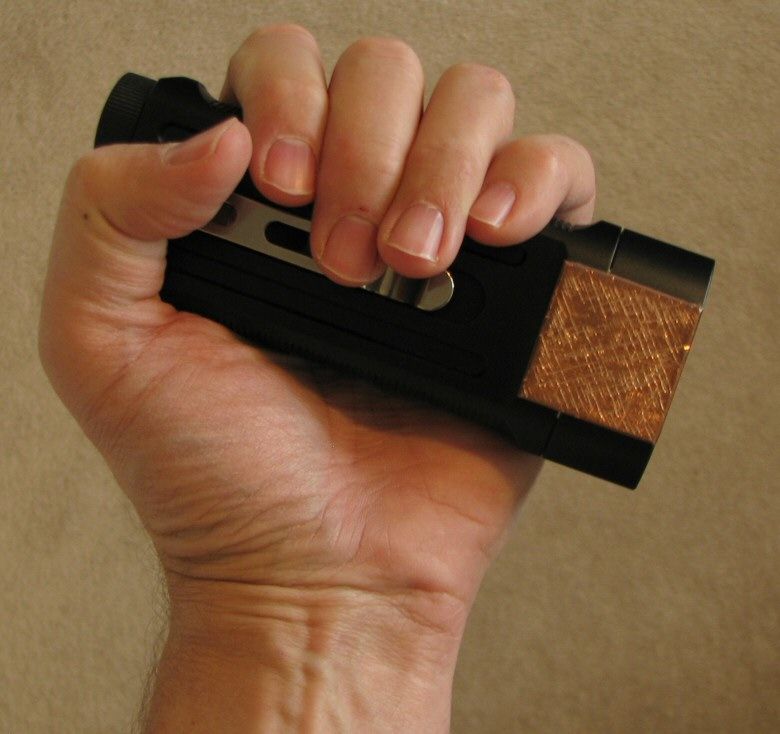
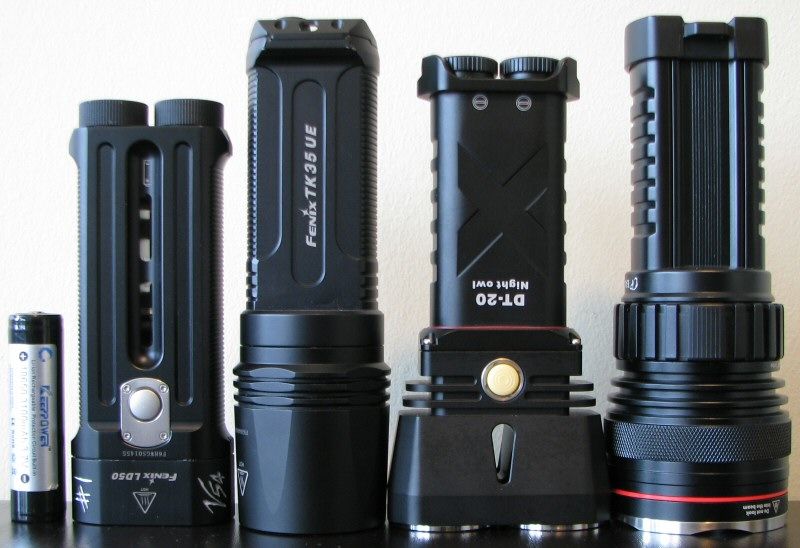
From left to right: Keeppower Protected 18650 3100mAh; V54 Fenix LD50vn; Fenix TK35UE, Skilhunt DT-20; Eagletac M3C4.
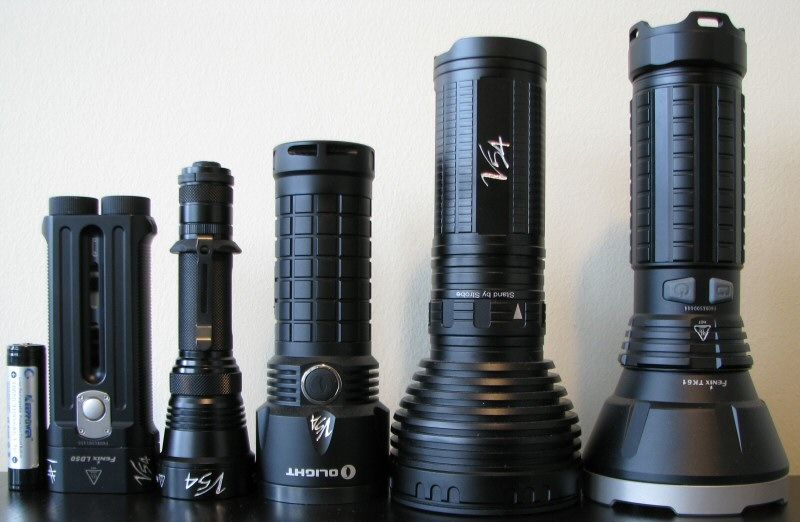
From left to right: Keeppower Protected 18650 3100mAh; V54 Fenix LD50vn, Eagletac S200C2vn, Olight SR52vn, Supbeam K50vn, Fenix TK61vn
All dimensions directly measured, and given with no batteries installed (unless indicated), and without the handle:
V54 Fenix LD50vn: Weight: 231.2g, Length: 137mm, Width (bezel): 28.2mm x 53.2mm
Fenix TK35UE: Weight 270g, Length 164mm, Width (bezel): 48.6mm
Eagletac SX25L3: Weight: 315.9g, Length: 150.2mm, Weight (bezel): 47.0mm
Olight SR52vn: Weight: 401.1g (501g with 6xCR123A), Length: 162mm, Width (bezel): 63.1mm
Olight SR Mini: Weight: 285.5g, Length: 126.9mm, Width (bezel): 48.1mm
Skilhunt DT-20: Weight 280.0g, Length: 152mm Width (bezel): 72.8mm and 36.8mm
SupBeam K50: Weight: 645.0g, Length: 230mm, Width (bezel): 90.1mm
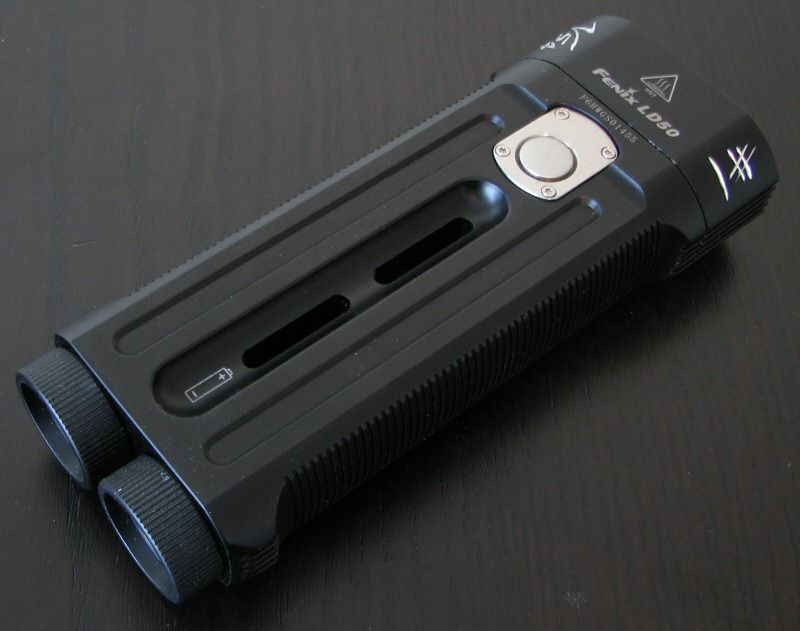
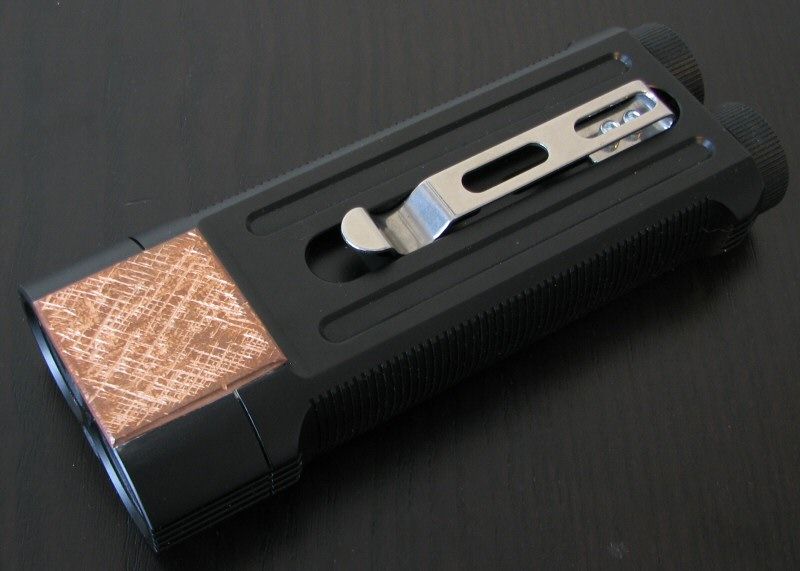
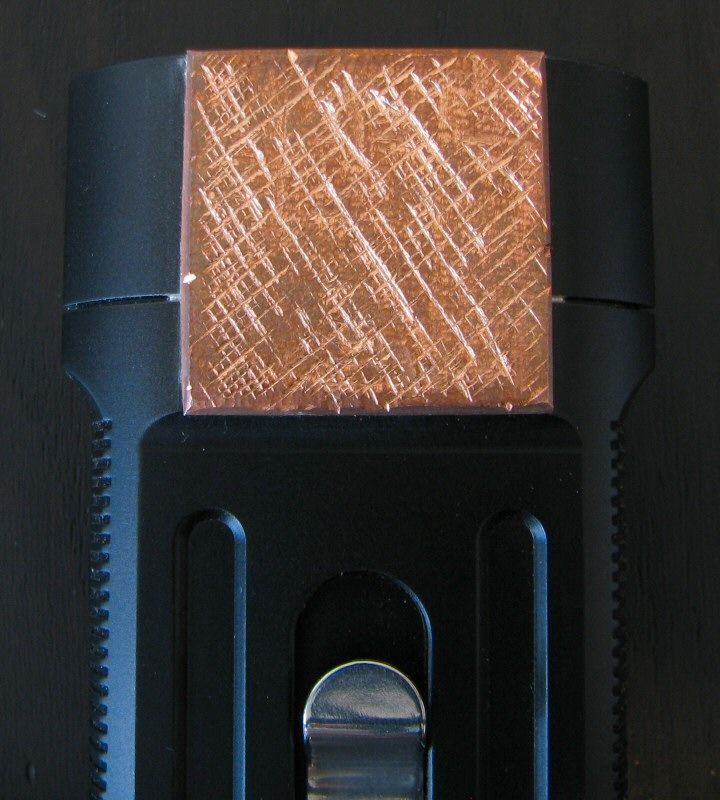
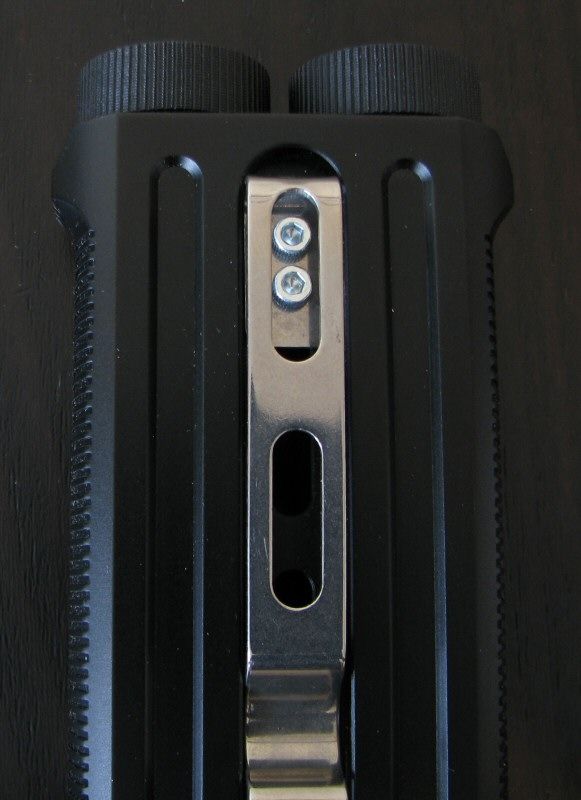
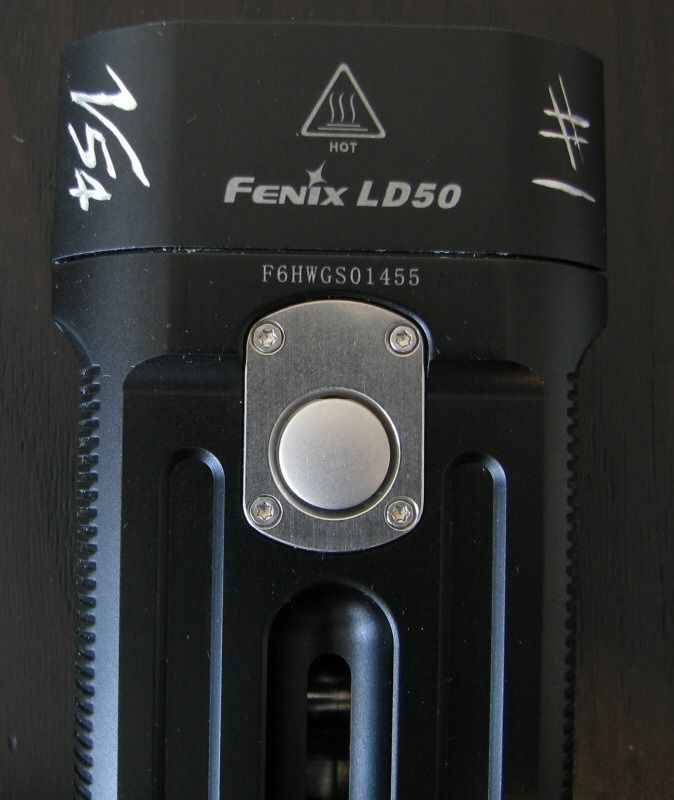
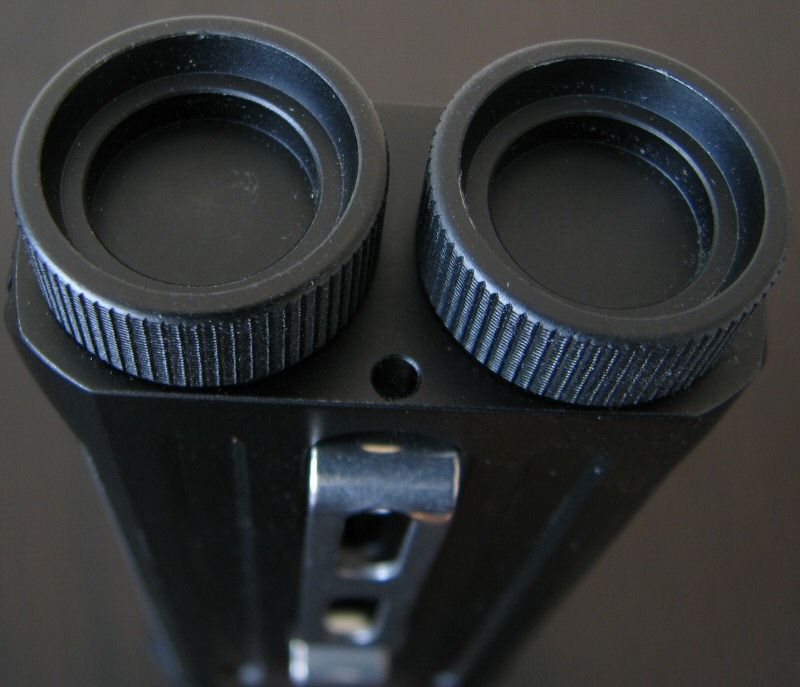
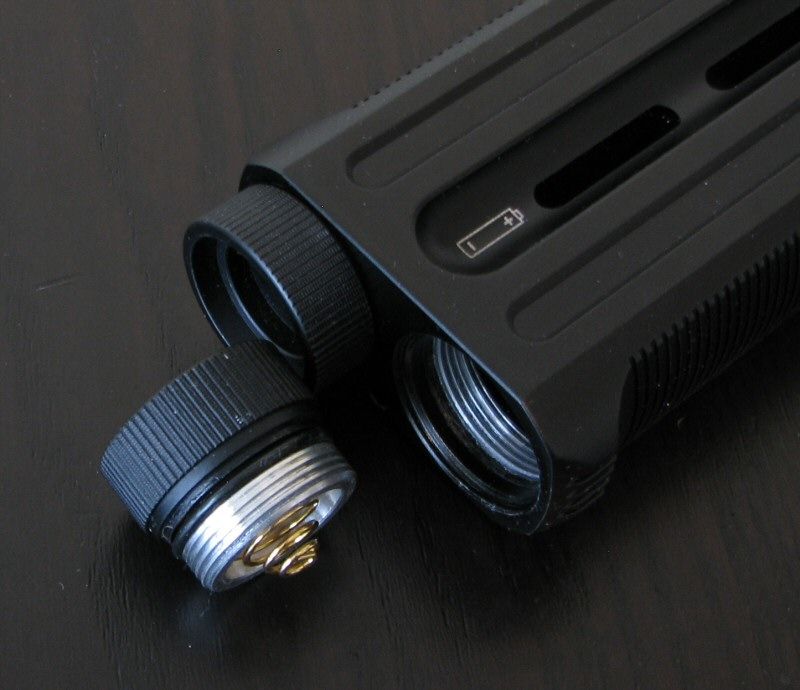
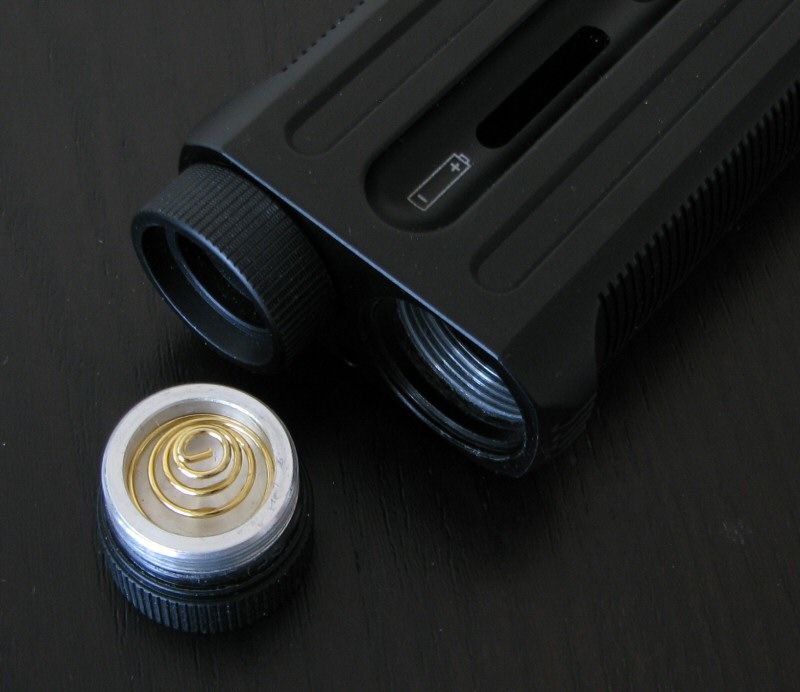
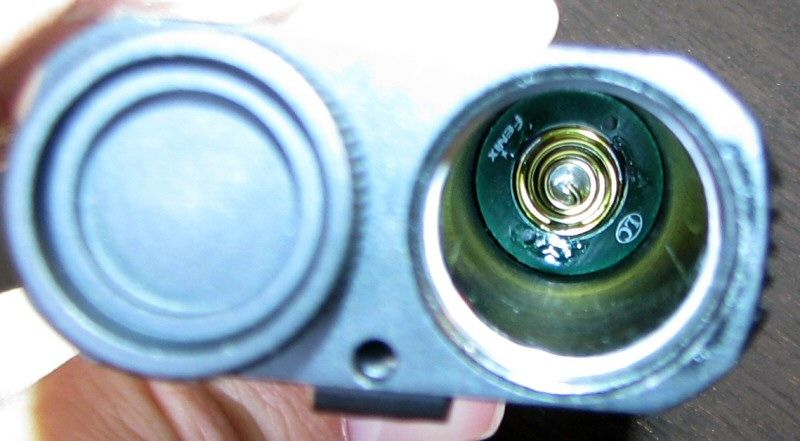
Overall size and dimensions of the LD50 are quite compact for the 2x18650 size class. This is definitely an unusual design, with the streamlined head to match the body (i.e., a very rectangular build).
Unlike many of Vinh's offerings, there is a very definite external distinctiveness to the LD50vn – thanks to the addition of an external copper heatsink bonded directly to the aluminum body. This is required to allow Vinh to drive the emitters/circuit to their maximal outputs. The custom engraving is other obvious giveaway of the modded nature of this light. And the dedomed emitters on my sample are another clue.
Anodizing is matte black finish. There is no real knurling to speak of, but there are various ridges and cut-outs to help with grip. The included pocket clip (held in place by removable hex screws) also helps. With the rectangular body, I would say the grip is better than most lights.
Stock body labels are minimal. Lettering is bright white and clear against the black background.
The light opens at the tailcaps only. Interestingly, there are two independent battery wells (for each of the two 18650 cells). Tail threads are square-cut, but not anodized (so no lock out is possible). I have seen a variant this design before, on the Skilhunt DT-20. The LD50 is similar in the sense that there is some independent control of the emitters by specific battery well. In the case of the LD50, this is complete – each emitter is separately controlled by each battery well (although the single switch controls the common output level set for both). The control button has a metal cover and surround. See the User Interface section later in this review for more info.
The built-in wells take all widths of 18650s in my collection. And thanks for the spring in the head, flat top cells will work reliably.
Note that while the user can only access the light through the tailcaps, physically this design necessitates the use of separate screws to hold the head and body units together (i.e., you can't just attach them together directly, as you can with cylindrical lights). The screws in this case are hidden under rubber plugs on the face of the light (see below). The LD50 build seems better in this regard than some of the early attempts in the 2x18650 class (e.g., Eagletac M2C4/M3C4, Skilhunt DT-20, etc.). However, according to Vinh, the heatsinking is quite limited on the stock form – so I recommend you go with his externally bonded copper heatsink mod.
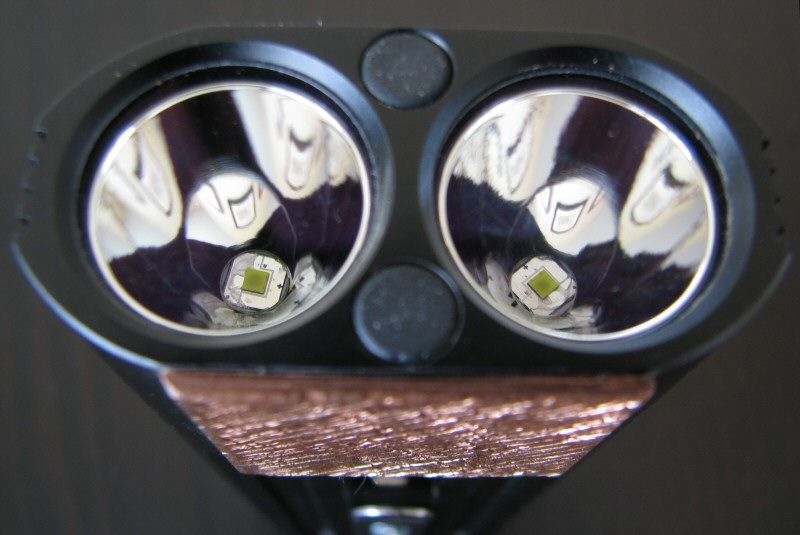
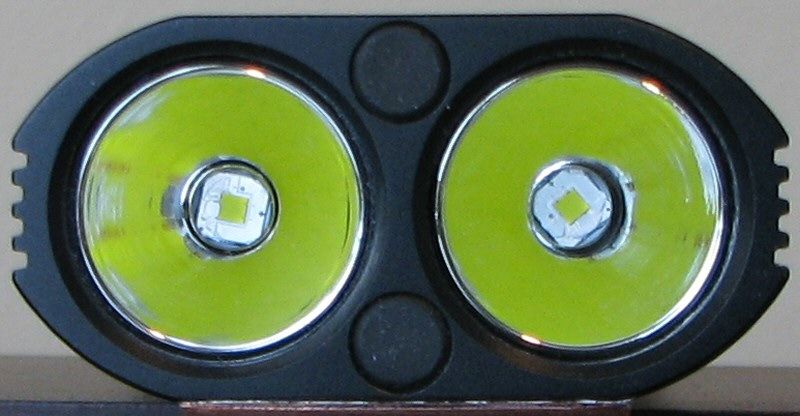
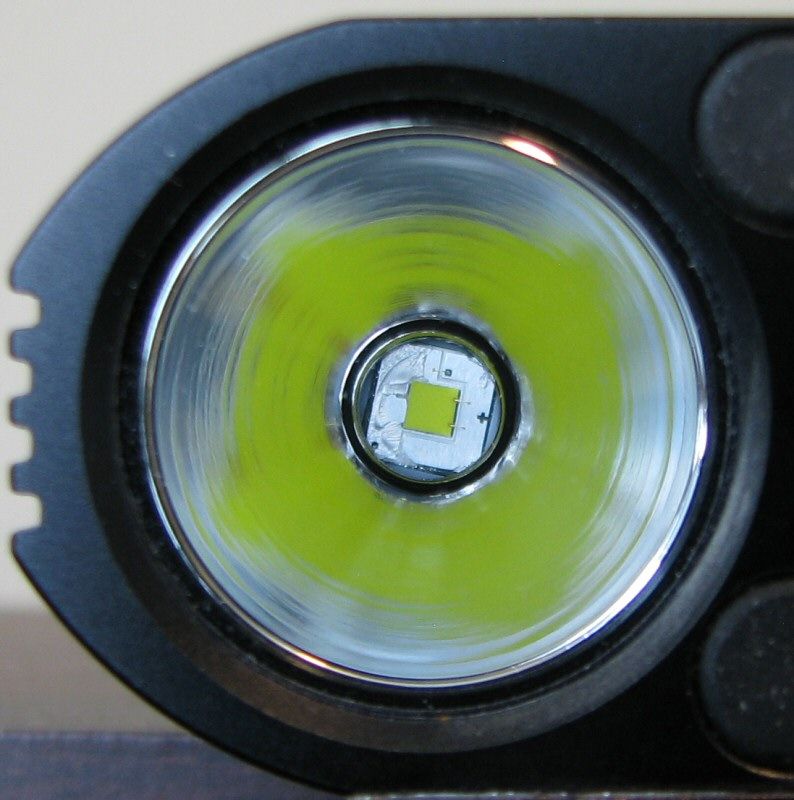
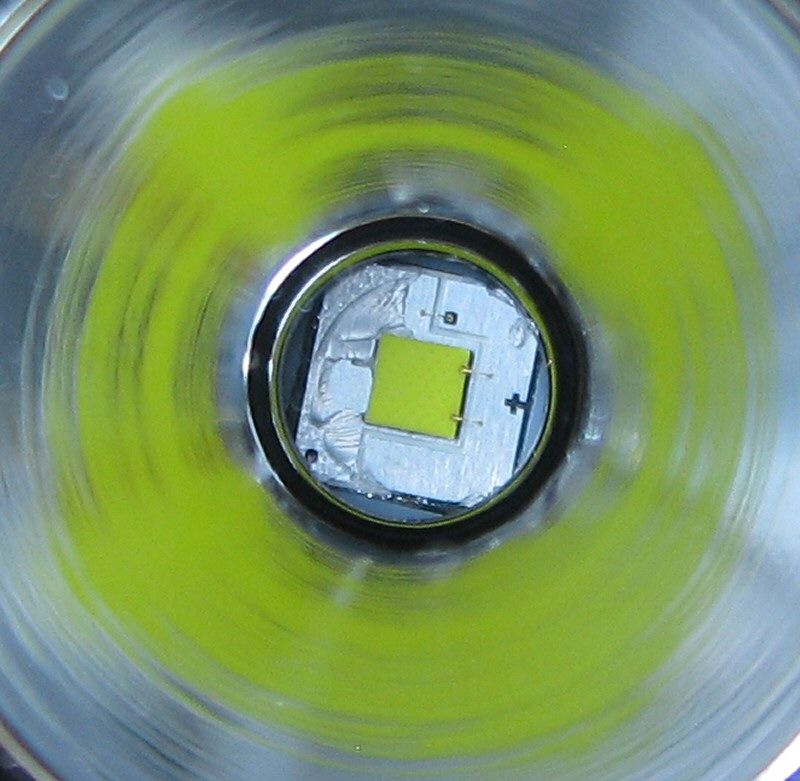
Again, my review sample is of the dedomed version of the LD50vn. Stock LD50s would show a fairly typical pattern for such relatively small individual reflectors
The dedoming process greatly improves the focusing of the light. Although Vinh offers a number of emitter choices with most of his light, it is typically the dedome models that most people crave.
Scroll down for beamshots and direct intensity measures. :wave:
User Interface
The general UI is unaffected by the mod, but the output levels are certainly very different (scroll down for a discussion).
Turn the light on or off by a press-and-hold of the switch (i.e., hold for at least ~0.5 secs before releasing).
Change output modes by clicking the switch. Mode sequence is Eco > Lo > Med > Hi > Turbo, in a repeating loop. The light has mode memory, and returns to the last level used after off-on. Note that you may not be able to see any difference between Hi and Turbo on the modded LD50vn - scroll down to my testing results to see the relative output level for each mode.
There is a "hidden" Strobe accessible from either On or Off by pressing and holding the switch for longer than it takes to turn the light On or Off. It takes >1 sec of sustained press to activate the Strobe mode. This means you will pass through the previously memorized On mode (if activating from Off), or pass through Off (if activating from On), en route to Strobe.
On the stock LD50, the Strobe is momentary-only if activated from Off. However, on my LD50vn, Strobe remains constant on if activated from either On or Off.
Video:
For more information on the modded LD50vn, please see my brief overview here:
As with all my videos, I recommend you have annotations turned on. I commonly update the commentary with additional information or clarifications before publicly releasing the video.
PWM/Strobe
There is no sign of flicker or PWM that I can see, at any output level – I believe the light is current-controlled.
There was however a faint re-occurring signal detectable on Med level:
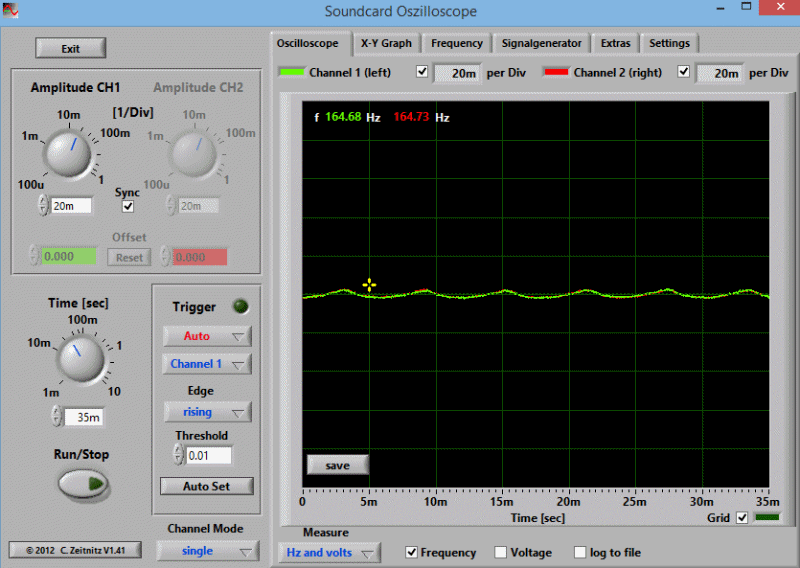
This is similar in pattern to what I detected in my recent review of the Fenix LD60 – but FAR less noticeable in practice. Please see that review for an example where these kinds of circuit signals can be strong enough to be detectable visually. Rest assured, there is no sign of flicker on any level on LD50vn. )
Strobe:
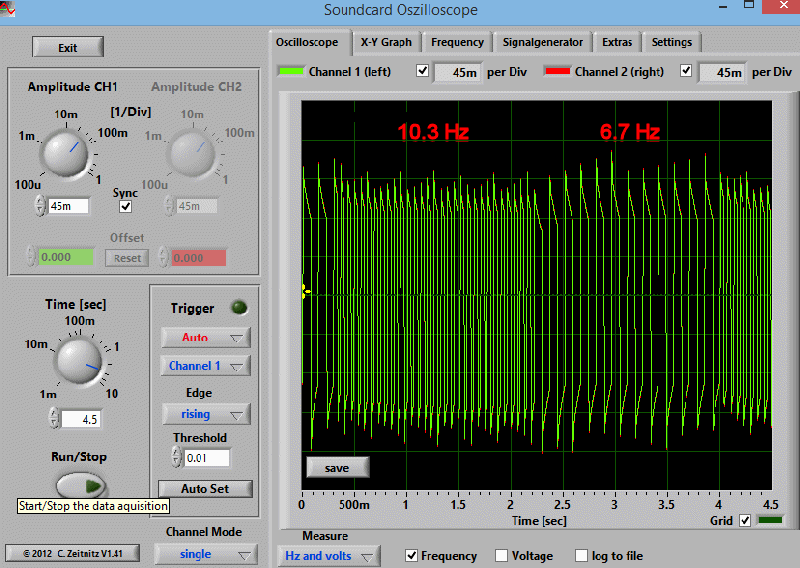
Strobe is an oscillating strobe, switching between two frequencies every 2 secs (10.3 Hz and 6.7Hz). Here is a close up of each freq:
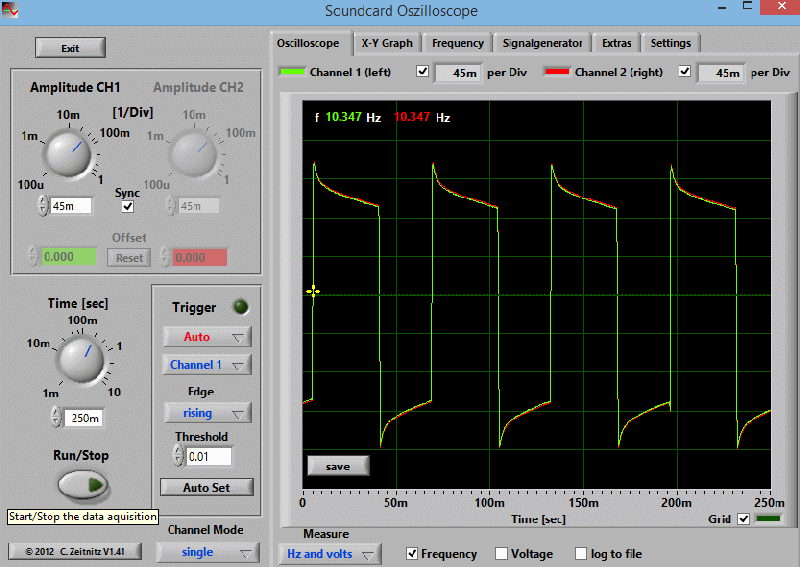
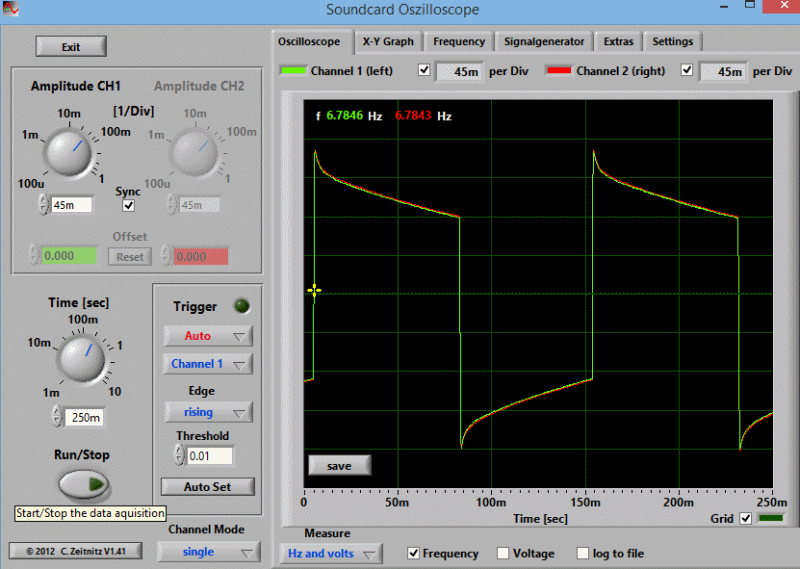
Standby Drain
A standby current drain is inevitable on this light, due to the electronic switch. As the the two wells appear to be independent, I have measured this individually and combined.
The good news is that the drain is completely negligible. With a single 18650 installed, I measured the drain as 1.5uA in either well (which would take centuries to drain the battery). With the two batteries installed, this current dropped down to 0.6uA per well/battery. As such, these are not a concern for drain.
With the two batteries installed, this current dropped down to 0.6uA per well/battery. As such, these are not a concern for drain.
Accidental activation is a still a concern, although this risk is mitigated slightly by the press-hold nature of the switch (for on/off). There is no lock-out mode that I am aware of though, and the tailcap threads are not anodized (so no physical lock-out is available either).
Beamshots:
And now, what you have all been waiting for. All lights are on 18650 batteries. Lights are about ~0.75 meter from a white wall (with the camera ~1.25 meters back from the wall). Automatic white balance used on the stock lights (to minimize tint differences), and Daylight white balance used on the V54 modded lights.
All lights are on 18650 batteries. Lights are about ~0.75 meter from a white wall (with the camera ~1.25 meters back from the wall). Automatic white balance used on the stock lights (to minimize tint differences), and Daylight white balance used on the V54 modded lights.
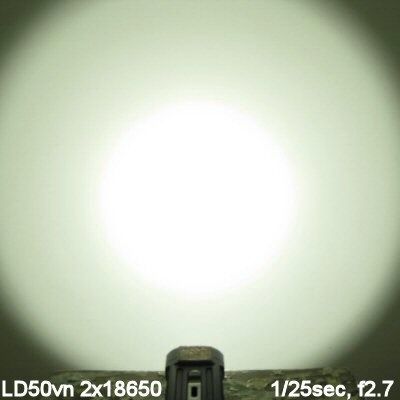
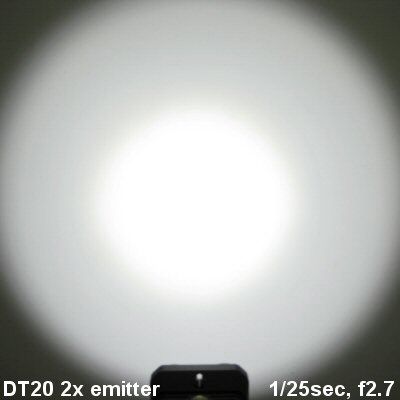
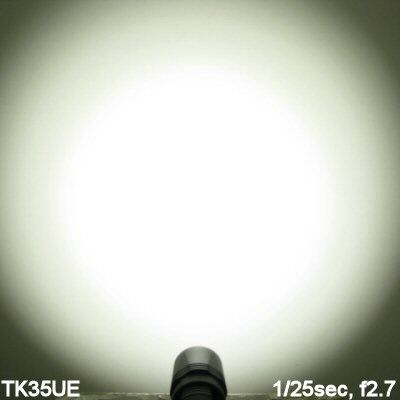
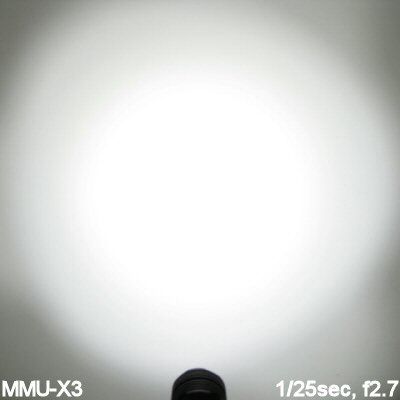
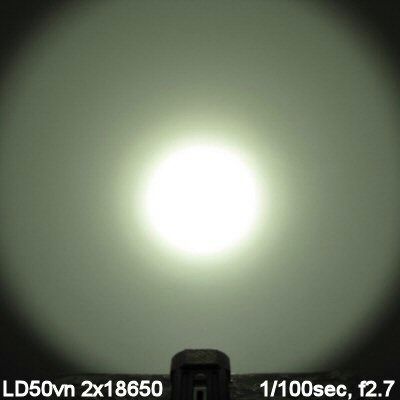
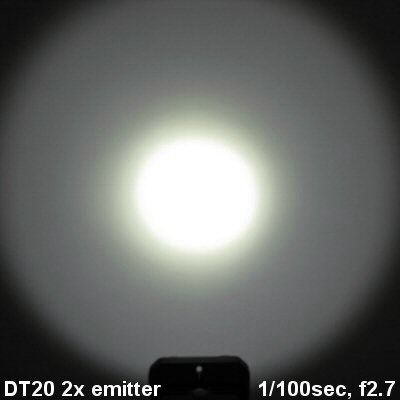
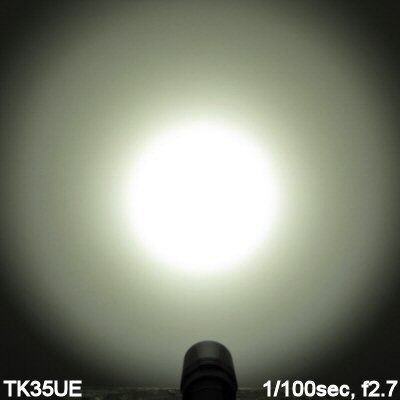
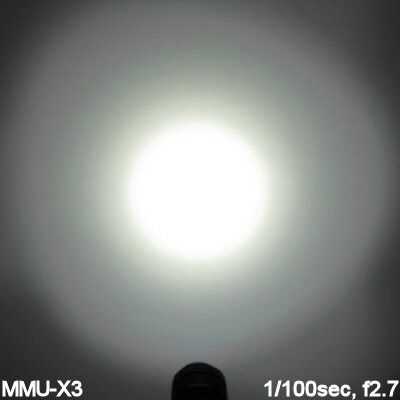
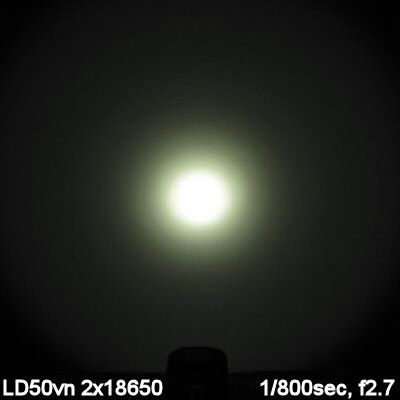
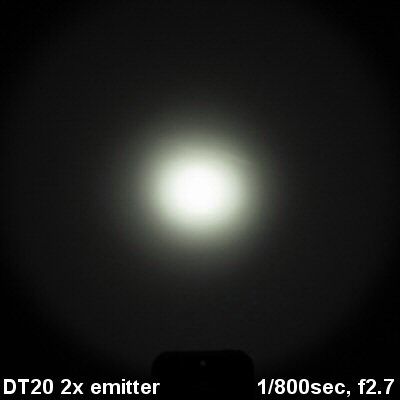
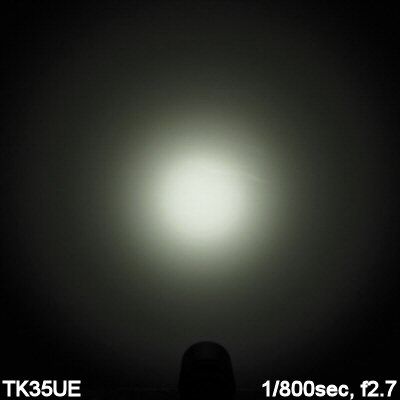
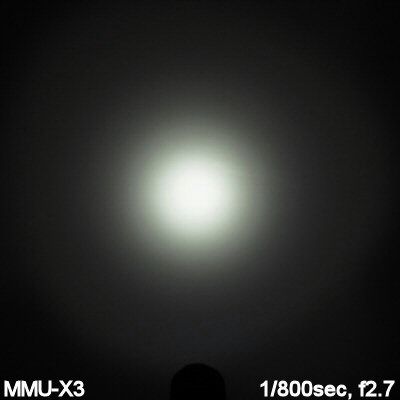
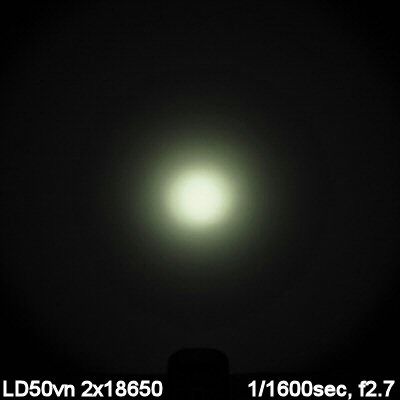
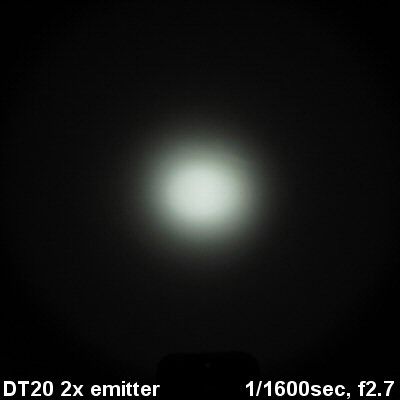
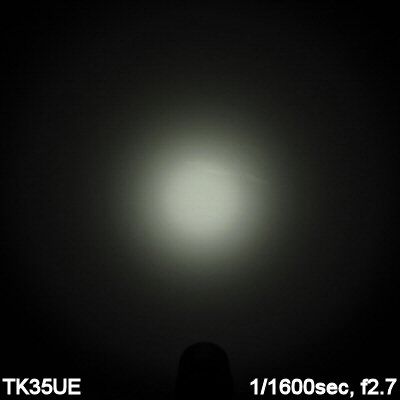
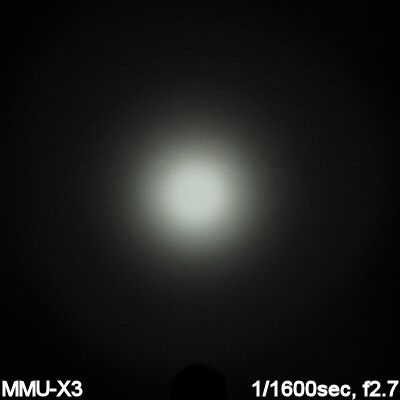
As usual, the dedoming process warms up the tint (and green-shifts it). That said, the light doesn't look as bad in real life as the daylight white balance above would suggest.
As you can see above, the LD50vn is quite "throwy" for a light this size – again thanks to the dedoming process. Scroll down for direct beam intensity measures.
But first, here is how the LD50vn compares to some other Vinh dedome models – including a comparison of how the 1x18650 and 2x18650 configurations appear (i.e., one emitter or two),

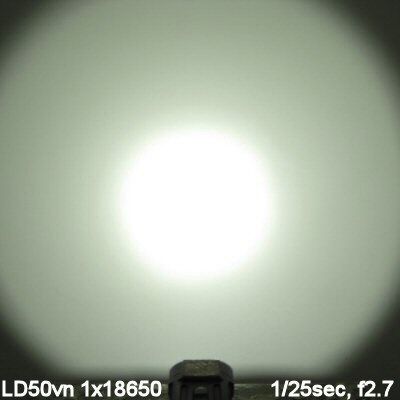
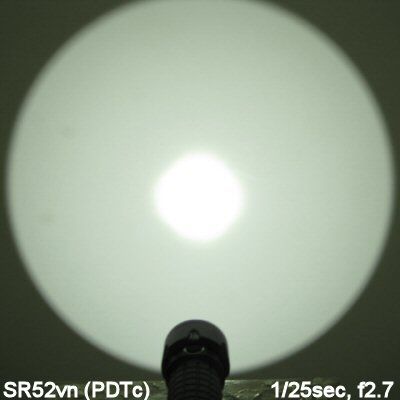
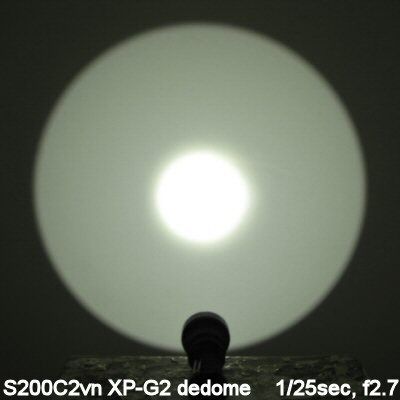
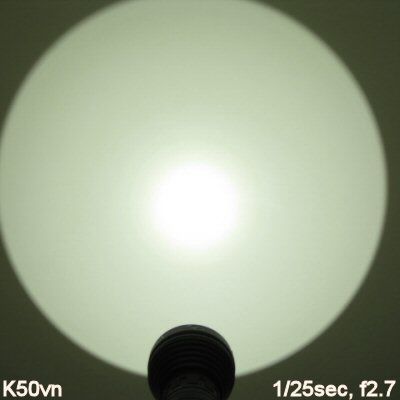

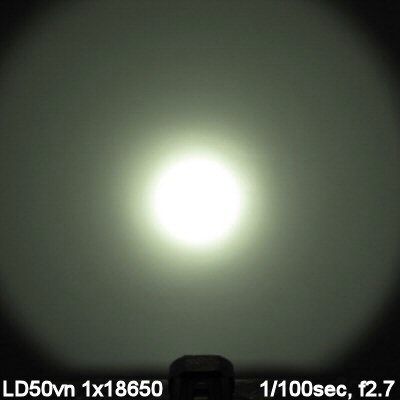
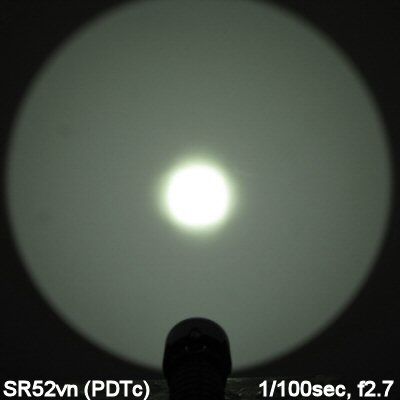
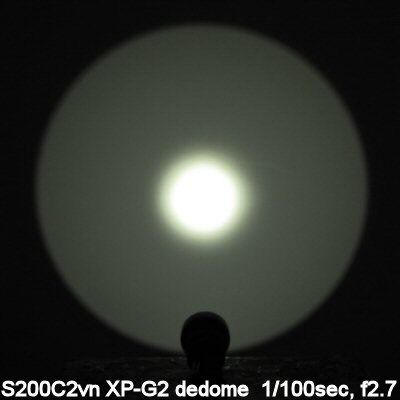
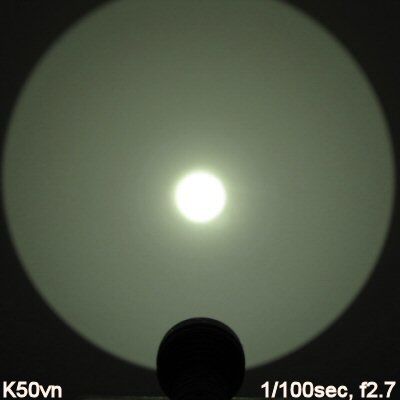

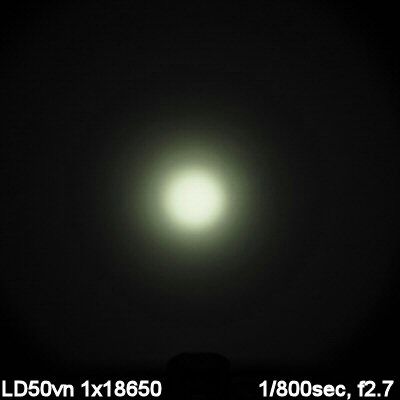
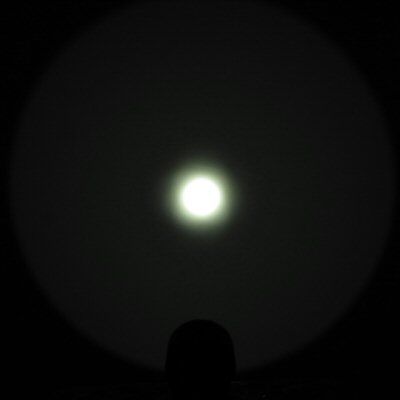
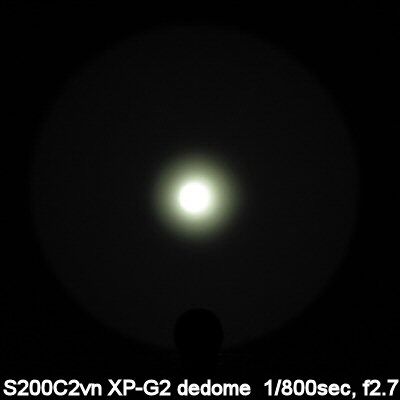
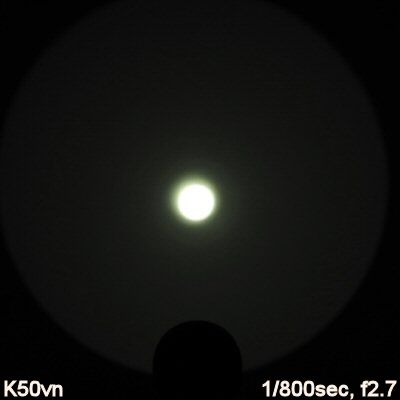

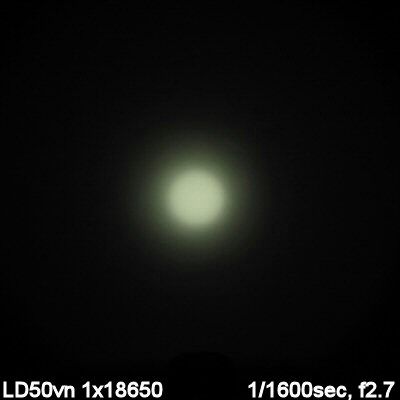
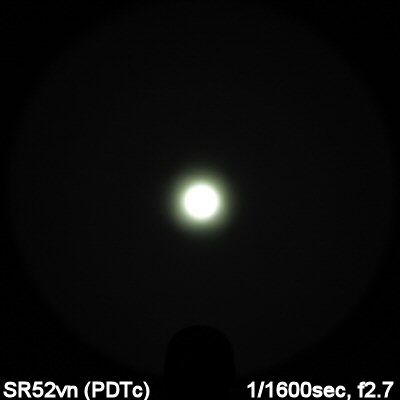
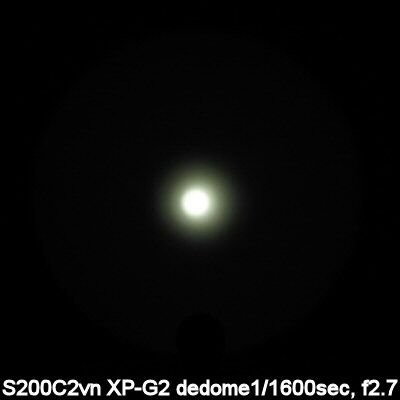
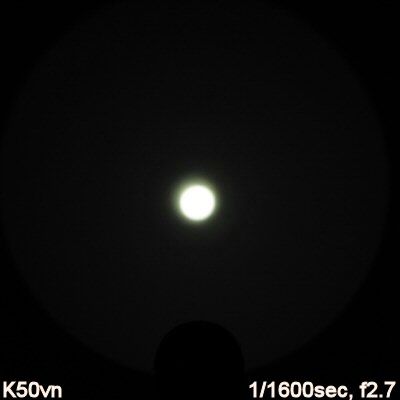
Clearly, the LD50vn can't throw as far as these lights with larger reflectors. But it does put out an impressive amount of overall output.
UPDATE OCTOBER 31, 2014: For outdoor shots, these are done in the style of my earlier 100-yard round-up review. Please see that thread for a discussion of the topography. In order to compare the various tints of different lights, I have locked the camera to Daylight (~5200K) white balance.
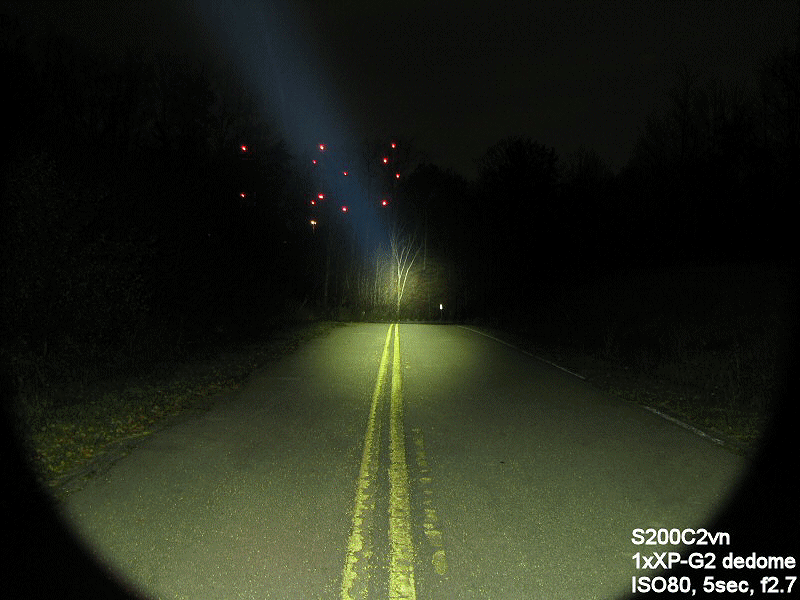
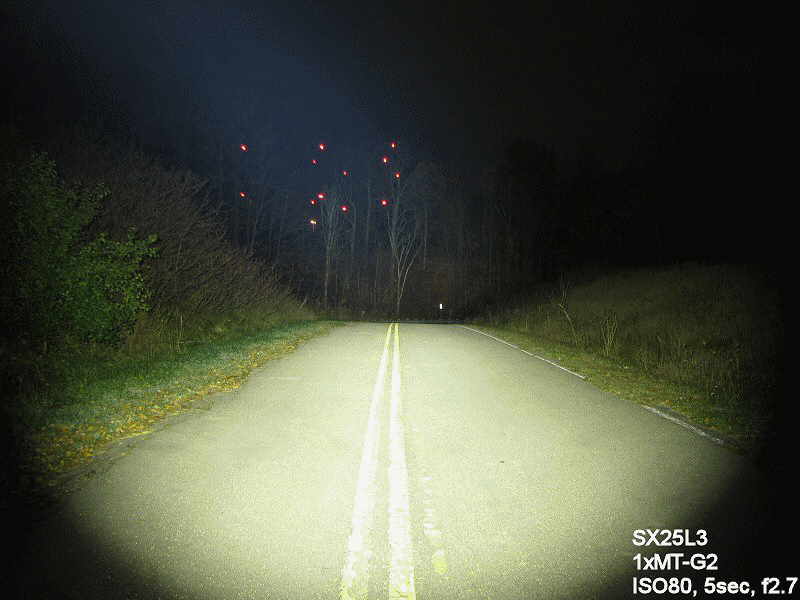
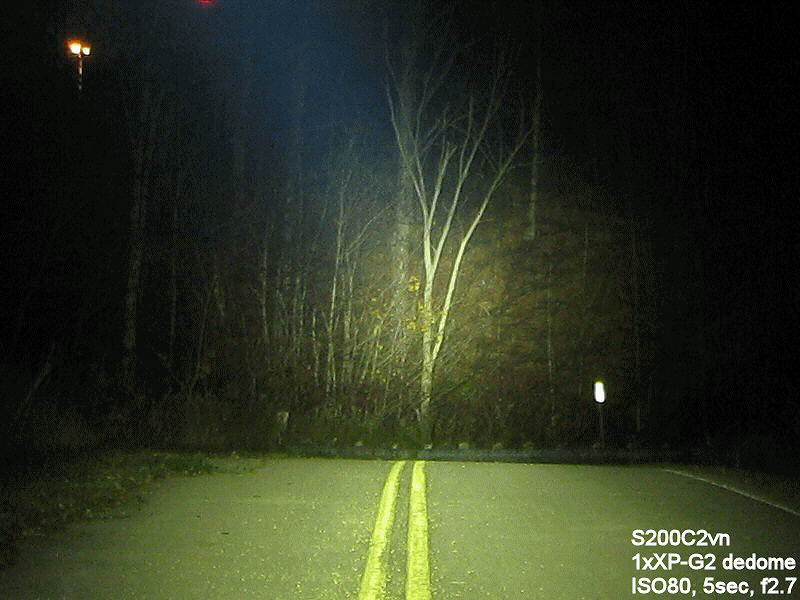
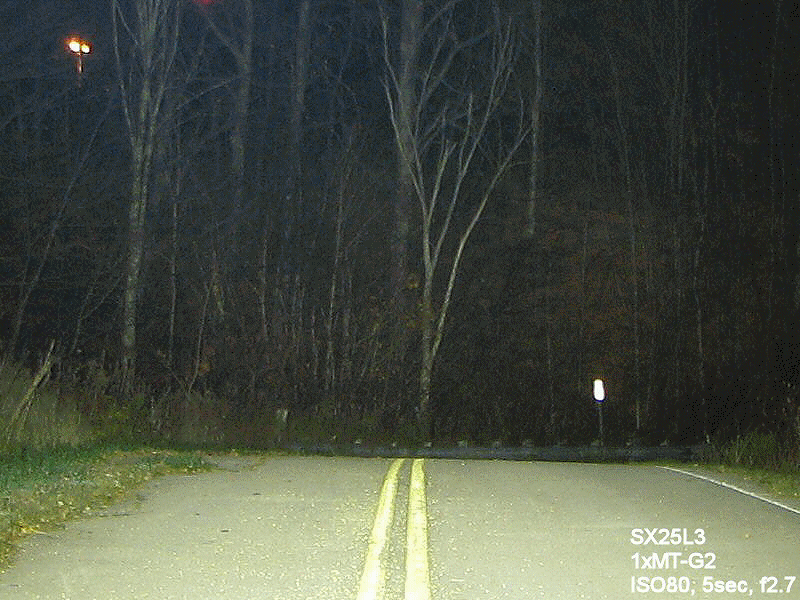
As you can see, the LD50vn doesn't throw as focused a beam as the throwy S200C2vn or SR52vn (nor would you expect it to). But it does provide a closer overall beam pattern to something like a moderate 3xXM-L2 thrower, like the stock Fenix LD60. Dome-on, I would expect the LD50vn to look something like the Eagletac SX25L3-MTG2 above.
Testing Method:
All my output numbers are relative for my home-made light box setup, as described on my flashlightreviews.ca website. You can directly compare all my relative output values from different reviews - i.e. an output value of "10" in one graph is the same as "10" in another. All runtimes are done under a cooling fan, except for any extended run Lo/Min modes (i.e. >12 hours) which are done without cooling.
I have devised a method for converting my lightbox relative output values (ROV) to estimated Lumens. See my How to convert Selfbuilt's Lightbox values to Lumens thread for more info.
Throw/Output Summary Chart:
My summary tables are reported in a manner consistent with the ANSI FL-1 standard for flashlight testing. Please see http://www.flashlightreviews.ca/FL1.htm for a discussion, and a description of all the terms used in these tables. Effective July 2012, I have updated all my Peak Intensity/Beam Distance measures with a NIST-certified Extech EA31 lightmeter (orange highlights).

First thing you will notice is that I am showing a comparison on standard 18650 cells (3100mAh Panasonic NCR18650A in this case) and higher-drain ranted INR cells (2000mAh Samsung 20R). Scroll down to runtimes for a discussion.
It is typically pretty variable how much Vinh can increase the current of stock lights (and thus increase their overall output). While Vinh is indeed able to squeeze a few more max lumens out of the LD50, dedoming of the emitter tends to reduce overall output (although greatly increases throw). As a result, the dedomed LD50vn tested here will only see a small increase in overall max output, compared to the stock emitter version. But it certainly produces much greater throw, as you would expect.
Let's see how the rest of the output levels compare, across battery types and number of emitters:
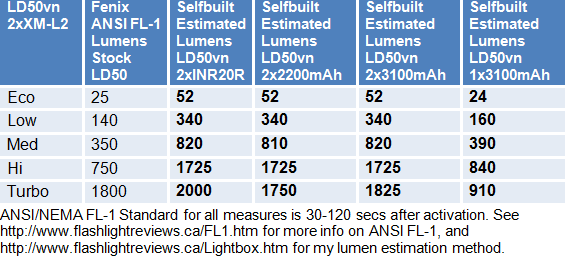
First off, this is one case where Vinh's mod definitely increases current at all levels – as you can above, it has more than doubled overall output at each level. Again, keep in mind that the dedoming here reduces overall output somewhat. Based on my experience with the MM15vn mods, I would expect the dome-on version of the LD50vn should be ~15-20% brighter than my PDTc sample - at each level above.
The second point is that you will need to use high-drain rated 18650 cells if you want to see greatest output increase on Turbo. If you look at my standard AW 2200mAh cells, there is basically no difference between Hi and Turbo. The 3100mAh NCR18650A cells do better, but it still is not a large difference. It is only once you go to the INR/IMR cells that you can see the true max output of the light.
This brings up an interesting point – Vinh states the factory step-down feature from Turbo seems to be disabled with mod. In fact, what I suspect is happening is that the output level of Hi and Turbo are in fact identical by the time step-down occurs (at 10 mins). So the feature may still be there – you just typically can't see any difference between the two levels at that point.
The third point to note above is that output is exactly halved if you only run on 18650 (i.e., only run one emitter). This is because the two emitters seem to have independent battery control, and the total output is thus the combined output of each common level.
Output/Runtime Graphs:
As always, all runtimes are done under a cooling fan.
Let's start with a comparison of the Turbo mode on the three types of batteries tested above:
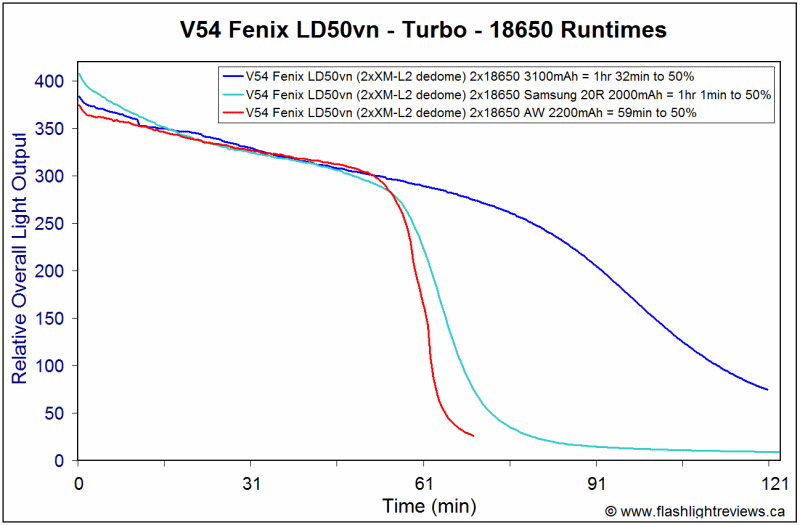
Again, the point here is that you would need INR/IMR/Hybrid cells to truly see the absolute max output initially. But after a few mins runtime, there really isn't an output difference between the cell types. As such, I recommend you stick with quality protected cells (like the NCR18650A 3100mAh) for best runtime performance without the risk of accidental over-discharge of unprotected INR/IMR/Hybrid cells.
By the way, the 3100mAh Turbo run shows that the step-down feature is indeed still present – see the small drop in output at 10 mins on Turbo? It is so small that you may not be able to notice it though (and you certainly can't see on the 2200mAh cells or the INR cells, where Turbo output has already dropped to same level as Hi output by this point).
It is so small that you may not be able to notice it though (and you certainly can't see on the 2200mAh cells or the INR cells, where Turbo output has already dropped to same level as Hi output by this point).
So how do Turbo, Hi and Med compare on my standard protected 18650 cells?
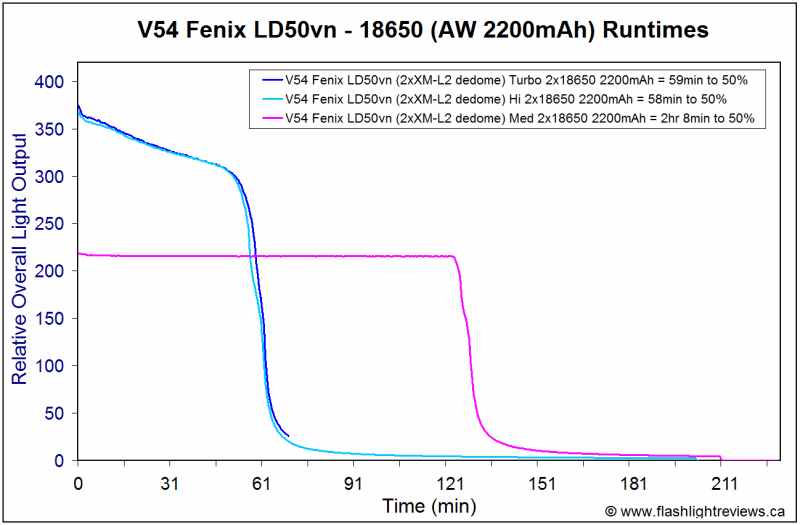
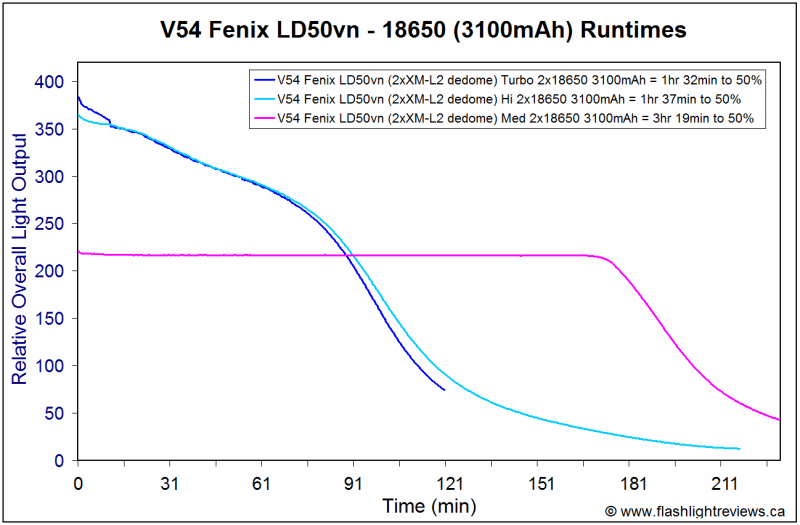
As expected, there is no difference between Hi or Turbo on the 2200mAh cells. For 3100mAh cells, you will see a small difference over the first ~10 mins or so, with freshly charged cells. Once step-down occurs at 10mins though, there is no difference from this point on.
As you will also see, only the Med (and lower modes) are fully flat-stabilized on the LD50vn. I can't know for certain what the stock LD50 would look like, but the LD50vn shows a direct-drive like pattern on Hi and Turbo.
How do things look with 1x vs 2x 18650, on Turbo?
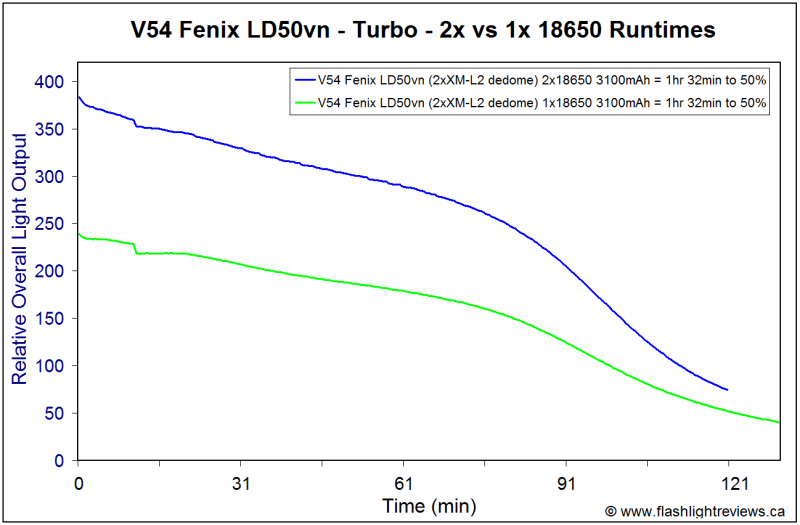
As you would expect, output is exactly half on the 1x18650/emitter situation – with identical runtime. Note that my relative lightbox output scale above is not linear with lumens – see my lumen estimation method described above for the power conversion explanation.
And again, you can see the step-down at 10 mins runtime in both cases on these 3100mAh cells.
All right, so how does the LD50vn compare to other lights out there? I've started to update my standard runtimes with 3100mAh cells (to replace my older 2200mAh runtimes), in order to illustrate the more typical condition for most people. For the time being, in order to maximize lights in the comparison, I will continue to show both sets of runtime comparisons, starting with 2200mAh cells below.
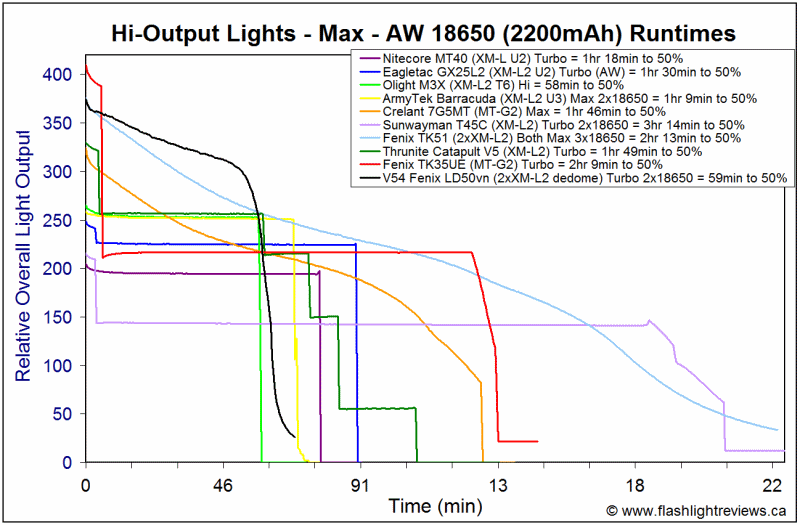
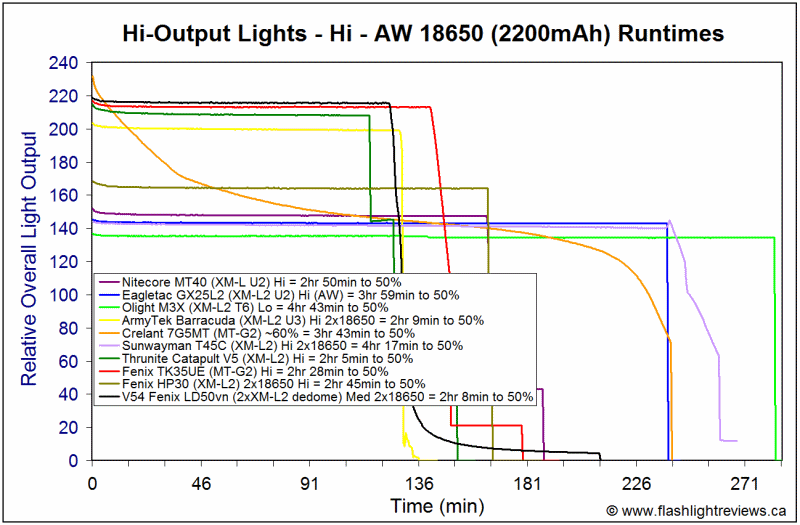
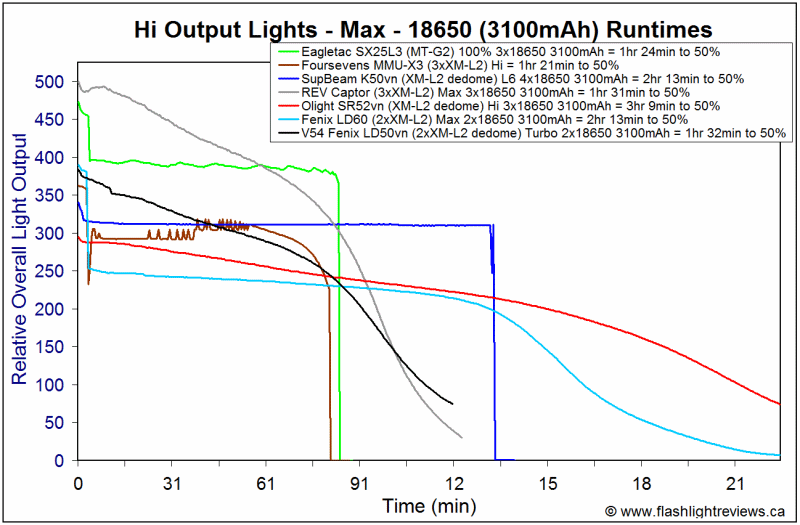
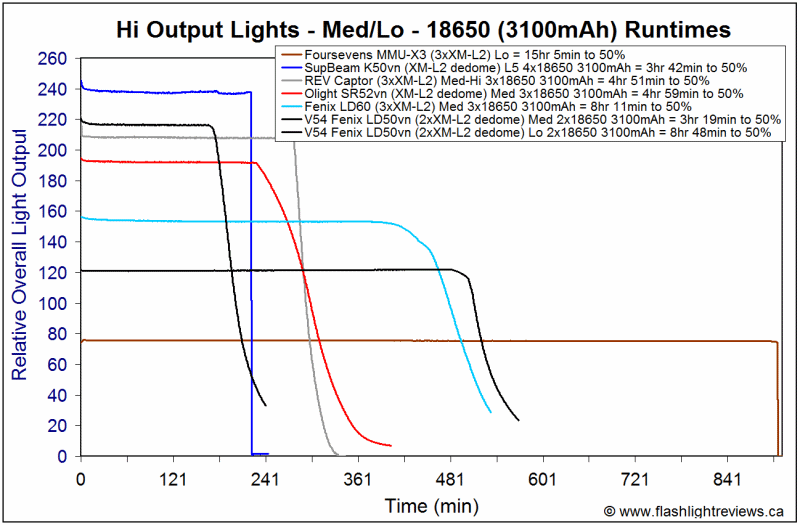
Overall output/runtime efficiency (which shouldn't be affected by the mod) is excellent, as expected. The LD50vn is very similar to the Fenix TK35UE – and other 2x18650 lights with good current-controlled circuits. :thumbsup:
Potential Issues
There is a single switch to control on/off and all output levels (i.e., there is no independent output control for the two emitter circuits).
There is a standby drain when a battery is connected, but it is completely negligible at ~1.5uA.
The risk of accidental activation is somewhat reduced by the need for a press-hold to activate the light – but there is no lockout mode that I am aware of. The individual battery wells have separate screw caps, which are not anodized (so no physical lock-out is possible).
The dual spring design caused some denting of my Samsung 20R INR positive terminals (although that may be related to the fact that I accidentally dropped the light 5 feet onto concrete with those cells in there). Since the screw threads are not anodized, there is no need to fully tighten the tailcaps. To be on the safe side, I recommend users check to make sure they are not over tightening.
Since the screw threads are not anodized, there is no need to fully tighten the tailcaps. To be on the safe side, I recommend users check to make sure they are not over tightening.
The default heatsinking pathway in the stock LD50 is apparently not great, so the mod here (with external copper heatsink bonded to the bare aluminum with thermal compound) is a good idea.
Dedoming of the emitter (to increase throw) also tends to produce a warmer overall beam tint – and slightly reduces overall output. As expected the "premium dedome tint" (PDTc) gave a slightly green-yellow tint (although not as bad as the white wall beamshots would suggest). Long-term reliability of dedomed emitters remains an unknown.
Modding of course voids all manufacturer warranties, but Vinh stands behind his products. Vinh also typically shores up circuit soldering and wires, which could lead to even greater longevity on the modded lights. Certainly the extra heatsinking here is a good idea.
Preliminary Observations
I must admit, my initial aesthetic assessment of the LD50 (based on pictures) was not entirely favorable. But once I held in the LD50vn in my hand, its design characteristics quickly won me over. This light is a comfortable to carry, well-balanced in the hand with good grip – and with very good throw in the dedome LD50vn version offered by Vinh.
I have always liked the side-by-side battery arrangement in AA or 18650 class lights – this keeps the light quite easily portable, while still being comfortable to hold. One issue with this fully rectangular design (including the head) is that you typically have to use separate screws to hold the head and body units together (i.e., you can't just screw them directly together, as you can with cylindrical head/tubes). But the LD50 build seems better in this regard than some of some of the early attempts in the 18650 class (e.g., Eagletac M2C4/M3C4, Skilhunt DT-20, etc.). Oh, and as an aside, my sample survived a 5-foot accidental fall onto concrete with only some minor damage to the anodizing on the head.
The single-switch design that Fenix has adopted on a number of recent lights (e.g., LD60 recently reviewed, and new E41) works well in my opinion. As someone who is of mixed handeness, two side-by-side buttons is simply not intuitive (i.e., I carry and use my lights in either hand, interchangeably).
Note that the LD50 is similar to the LD60 that I recently reviewed, in that the light can run on a reduced number of batteries. The emitters are powered directly from a specific battery well – omit one battery, and you will halve the overall output here (i.e., only one emitter lights up). :wave:
In the case of output/drive levels, there was a significant increase in overall output on all levels on my LD50vn, compared to stock specs. Again, overall output is reduced slightly by the dedoming, but I would say the sub-max levels are all increased by the circuit mod by at least ~150% (i.e., output levels of the LD50vn are ~2.5x those of the stock LD50). On Turbo, the max output is more modest (and somewhat dependent on the high drain characteristics of the batteries used). But Vinh has probably managed a ~20-25% max output upgrade here (more like ~5-10% on the dedome version).
The relative lack of throw on the stock LD50 version (due to the small reflector wells) was also something that didn't initially appeal to me in 2x18650 light. As such, I was quite happy to see how smooth the beam pattern was on the PDT sample Vinh sent (with a large hotspot with good throw). As usual for a Vinh dedome mod, peak beam intensity more than doubled on my PDTc sample, compared to stock (even taking into account the more modest output bump on the dedome version). :thumbsup:
Regulation and output/runtime performance of the LD50vn are as you would expect. Basically, due to the significantly higher output at each level, you can expect a large reduction in runtime (compared to stock specs). But the overall efficiency of the circuit remains unchanged. Since the Hi level is now driven to almost the same point as the Turbo level, you will not typically notice the step-down feature at 10 mins (although it is technically still there – see my runtimes for more info).
Since the Hi level is now driven to almost the same point as the Turbo level, you will not typically notice the step-down feature at 10 mins (although it is technically still there – see my runtimes for more info).
While I was initially unsure of the LD50 design, the dedome version of the LD50vn has won me over. It is a nice light to carry, with a great beam pattern on my sample. A strong contender if you are looking for a compact side-by-side arrangement 2x18650 light. :wave:
----
LD50vn provided by Vinh Nguyen (V54) for review.


The Fenix LD50 is one of the recent lights to have undergone Vinh's transformations. My review sample of the LD50vn features Vinh's PDTc ("premium dedome tint – cool white"), although versions with just the circuit modification are also available. For more information about the LD50vn, please see Vinh's LD50vn discussion thread here on CPF. For more information on the PDT, please see this thread from Vinh.
I have not reviewed the stock LD50, but will compare the LD50vn to other dual-cell and/or dual-emitter lights in my collection.
Stock Fenix LD50 Reported Specifications:
(note: as always, these are simply what the manufacturer provides – scroll down to see my actual testing results).
- Cree XM-L2 (U2) LED
- Powered by two 18650 rechargeable Li-ion battery or four 3V CR123A Lithium batteries
- Output mode / Runtime: Turbo: 1800 lumens / 1h 35min, High: 750 lumens / 4h, Mid: 350 lumens / 10h, Low: 140 lumens / 25h, Eco: 25 lumens / 150h, Strobe: 1800 lumens
- Dimensions and Weight: Length: 5.43" / 138mm, Width: 2.09" / 53mm, Height: 1.06" / 27mm, Weight: 7.76oz / 220gm
- Peak Beam Distance: 270m
- Peak Beam Intensit6y: 18,500cd
- Digitally regulated output - maintains constant brightness
- Low-voltage warning function to remind you to replace the battery
- Reverse polarity protection, to protect from improper battery installation
- Over heat protection to avoid high-temperature of the surface
- Ultra compact flat body design
- Built-in belt clip
- Intuitive one-button operation
- Made of durable aircraft-grade aluminum
- Premium Type III hard-anodized anti-abrasive finish
- Toughened ultra-clear glass lens with anti-reflective coating
- Waterproof: IPX-8 (underwater 2 meters)
- Impact: 1m
- MSRP: $120
- External copper heat sink option to greatly improve head to body conductivity. Black anodization removed and Arctic Silver thermal adhesive applied for good bonding.
- Factory step down seems to be disabled with mod.
- $150 XML2 6500K Dome on, Add thermal paste to key internal places, current boost
- + $30 XML2 PDTn, PDTc, or PDTw
- + $25 XML2 5000K, 4000K, 3000K
- + $10 Dedome Factory LED
- + $45 External Copper Heat Sink (expensive due to tough work)
- + $15 International Shipping
- + $5 "V54" hand engraving





As per usual for a V54-modded light, packaging of the LD50vn is the standard stock retail packaging of the LD50 (signed by Vinh). Printed on the sides and back are the key characteristics of the stock Fenix light. Inside, included with the light are spare O-rings, basic wrist lanyard, allen key (to remove the attached pocket clip), warranty card and manual.



From left to right: Keeppower Protected 18650 3100mAh; V54 Fenix LD50vn; Fenix TK35UE, Skilhunt DT-20; Eagletac M3C4.

From left to right: Keeppower Protected 18650 3100mAh; V54 Fenix LD50vn, Eagletac S200C2vn, Olight SR52vn, Supbeam K50vn, Fenix TK61vn
All dimensions directly measured, and given with no batteries installed (unless indicated), and without the handle:
V54 Fenix LD50vn: Weight: 231.2g, Length: 137mm, Width (bezel): 28.2mm x 53.2mm
Fenix TK35UE: Weight 270g, Length 164mm, Width (bezel): 48.6mm
Eagletac SX25L3: Weight: 315.9g, Length: 150.2mm, Weight (bezel): 47.0mm
Olight SR52vn: Weight: 401.1g (501g with 6xCR123A), Length: 162mm, Width (bezel): 63.1mm
Olight SR Mini: Weight: 285.5g, Length: 126.9mm, Width (bezel): 48.1mm
Skilhunt DT-20: Weight 280.0g, Length: 152mm Width (bezel): 72.8mm and 36.8mm
SupBeam K50: Weight: 645.0g, Length: 230mm, Width (bezel): 90.1mm









Overall size and dimensions of the LD50 are quite compact for the 2x18650 size class. This is definitely an unusual design, with the streamlined head to match the body (i.e., a very rectangular build).
Unlike many of Vinh's offerings, there is a very definite external distinctiveness to the LD50vn – thanks to the addition of an external copper heatsink bonded directly to the aluminum body. This is required to allow Vinh to drive the emitters/circuit to their maximal outputs. The custom engraving is other obvious giveaway of the modded nature of this light. And the dedomed emitters on my sample are another clue.
Anodizing is matte black finish. There is no real knurling to speak of, but there are various ridges and cut-outs to help with grip. The included pocket clip (held in place by removable hex screws) also helps. With the rectangular body, I would say the grip is better than most lights.
Stock body labels are minimal. Lettering is bright white and clear against the black background.
The light opens at the tailcaps only. Interestingly, there are two independent battery wells (for each of the two 18650 cells). Tail threads are square-cut, but not anodized (so no lock out is possible). I have seen a variant this design before, on the Skilhunt DT-20. The LD50 is similar in the sense that there is some independent control of the emitters by specific battery well. In the case of the LD50, this is complete – each emitter is separately controlled by each battery well (although the single switch controls the common output level set for both). The control button has a metal cover and surround. See the User Interface section later in this review for more info.
The built-in wells take all widths of 18650s in my collection. And thanks for the spring in the head, flat top cells will work reliably.
Note that while the user can only access the light through the tailcaps, physically this design necessitates the use of separate screws to hold the head and body units together (i.e., you can't just attach them together directly, as you can with cylindrical lights). The screws in this case are hidden under rubber plugs on the face of the light (see below). The LD50 build seems better in this regard than some of the early attempts in the 2x18650 class (e.g., Eagletac M2C4/M3C4, Skilhunt DT-20, etc.). However, according to Vinh, the heatsinking is quite limited on the stock form – so I recommend you go with his externally bonded copper heatsink mod.




Again, my review sample is of the dedomed version of the LD50vn. Stock LD50s would show a fairly typical pattern for such relatively small individual reflectors
The dedoming process greatly improves the focusing of the light. Although Vinh offers a number of emitter choices with most of his light, it is typically the dedome models that most people crave.
Scroll down for beamshots and direct intensity measures. :wave:
User Interface
The general UI is unaffected by the mod, but the output levels are certainly very different (scroll down for a discussion).
Turn the light on or off by a press-and-hold of the switch (i.e., hold for at least ~0.5 secs before releasing).
Change output modes by clicking the switch. Mode sequence is Eco > Lo > Med > Hi > Turbo, in a repeating loop. The light has mode memory, and returns to the last level used after off-on. Note that you may not be able to see any difference between Hi and Turbo on the modded LD50vn - scroll down to my testing results to see the relative output level for each mode.
There is a "hidden" Strobe accessible from either On or Off by pressing and holding the switch for longer than it takes to turn the light On or Off. It takes >1 sec of sustained press to activate the Strobe mode. This means you will pass through the previously memorized On mode (if activating from Off), or pass through Off (if activating from On), en route to Strobe.
On the stock LD50, the Strobe is momentary-only if activated from Off. However, on my LD50vn, Strobe remains constant on if activated from either On or Off.
Video:
For more information on the modded LD50vn, please see my brief overview here:
As with all my videos, I recommend you have annotations turned on. I commonly update the commentary with additional information or clarifications before publicly releasing the video.
PWM/Strobe
There is no sign of flicker or PWM that I can see, at any output level – I believe the light is current-controlled.
There was however a faint re-occurring signal detectable on Med level:

This is similar in pattern to what I detected in my recent review of the Fenix LD60 – but FAR less noticeable in practice. Please see that review for an example where these kinds of circuit signals can be strong enough to be detectable visually. Rest assured, there is no sign of flicker on any level on LD50vn. )
Strobe:

Strobe is an oscillating strobe, switching between two frequencies every 2 secs (10.3 Hz and 6.7Hz). Here is a close up of each freq:


Standby Drain
A standby current drain is inevitable on this light, due to the electronic switch. As the the two wells appear to be independent, I have measured this individually and combined.
The good news is that the drain is completely negligible. With a single 18650 installed, I measured the drain as 1.5uA in either well (which would take centuries to drain the battery).
Accidental activation is a still a concern, although this risk is mitigated slightly by the press-hold nature of the switch (for on/off). There is no lock-out mode that I am aware of though, and the tailcap threads are not anodized (so no physical lock-out is available either).
Beamshots:
And now, what you have all been waiting for.
















As usual, the dedoming process warms up the tint (and green-shifts it). That said, the light doesn't look as bad in real life as the daylight white balance above would suggest.
As you can see above, the LD50vn is quite "throwy" for a light this size – again thanks to the dedoming process. Scroll down for direct beam intensity measures.
But first, here is how the LD50vn compares to some other Vinh dedome models – including a comparison of how the 1x18650 and 2x18650 configurations appear (i.e., one emitter or two),




















Clearly, the LD50vn can't throw as far as these lights with larger reflectors. But it does put out an impressive amount of overall output.
UPDATE OCTOBER 31, 2014: For outdoor shots, these are done in the style of my earlier 100-yard round-up review. Please see that thread for a discussion of the topography. In order to compare the various tints of different lights, I have locked the camera to Daylight (~5200K) white balance.




As you can see, the LD50vn doesn't throw as focused a beam as the throwy S200C2vn or SR52vn (nor would you expect it to). But it does provide a closer overall beam pattern to something like a moderate 3xXM-L2 thrower, like the stock Fenix LD60. Dome-on, I would expect the LD50vn to look something like the Eagletac SX25L3-MTG2 above.
Testing Method:
All my output numbers are relative for my home-made light box setup, as described on my flashlightreviews.ca website. You can directly compare all my relative output values from different reviews - i.e. an output value of "10" in one graph is the same as "10" in another. All runtimes are done under a cooling fan, except for any extended run Lo/Min modes (i.e. >12 hours) which are done without cooling.
I have devised a method for converting my lightbox relative output values (ROV) to estimated Lumens. See my How to convert Selfbuilt's Lightbox values to Lumens thread for more info.
Throw/Output Summary Chart:
My summary tables are reported in a manner consistent with the ANSI FL-1 standard for flashlight testing. Please see http://www.flashlightreviews.ca/FL1.htm for a discussion, and a description of all the terms used in these tables. Effective July 2012, I have updated all my Peak Intensity/Beam Distance measures with a NIST-certified Extech EA31 lightmeter (orange highlights).

First thing you will notice is that I am showing a comparison on standard 18650 cells (3100mAh Panasonic NCR18650A in this case) and higher-drain ranted INR cells (2000mAh Samsung 20R). Scroll down to runtimes for a discussion.
It is typically pretty variable how much Vinh can increase the current of stock lights (and thus increase their overall output). While Vinh is indeed able to squeeze a few more max lumens out of the LD50, dedoming of the emitter tends to reduce overall output (although greatly increases throw). As a result, the dedomed LD50vn tested here will only see a small increase in overall max output, compared to the stock emitter version. But it certainly produces much greater throw, as you would expect.
Let's see how the rest of the output levels compare, across battery types and number of emitters:

First off, this is one case where Vinh's mod definitely increases current at all levels – as you can above, it has more than doubled overall output at each level. Again, keep in mind that the dedoming here reduces overall output somewhat. Based on my experience with the MM15vn mods, I would expect the dome-on version of the LD50vn should be ~15-20% brighter than my PDTc sample - at each level above.
The second point is that you will need to use high-drain rated 18650 cells if you want to see greatest output increase on Turbo. If you look at my standard AW 2200mAh cells, there is basically no difference between Hi and Turbo. The 3100mAh NCR18650A cells do better, but it still is not a large difference. It is only once you go to the INR/IMR cells that you can see the true max output of the light.
This brings up an interesting point – Vinh states the factory step-down feature from Turbo seems to be disabled with mod. In fact, what I suspect is happening is that the output level of Hi and Turbo are in fact identical by the time step-down occurs (at 10 mins). So the feature may still be there – you just typically can't see any difference between the two levels at that point.
The third point to note above is that output is exactly halved if you only run on 18650 (i.e., only run one emitter). This is because the two emitters seem to have independent battery control, and the total output is thus the combined output of each common level.
Output/Runtime Graphs:
As always, all runtimes are done under a cooling fan.
Let's start with a comparison of the Turbo mode on the three types of batteries tested above:

Again, the point here is that you would need INR/IMR/Hybrid cells to truly see the absolute max output initially. But after a few mins runtime, there really isn't an output difference between the cell types. As such, I recommend you stick with quality protected cells (like the NCR18650A 3100mAh) for best runtime performance without the risk of accidental over-discharge of unprotected INR/IMR/Hybrid cells.
By the way, the 3100mAh Turbo run shows that the step-down feature is indeed still present – see the small drop in output at 10 mins on Turbo?
So how do Turbo, Hi and Med compare on my standard protected 18650 cells?


As expected, there is no difference between Hi or Turbo on the 2200mAh cells. For 3100mAh cells, you will see a small difference over the first ~10 mins or so, with freshly charged cells. Once step-down occurs at 10mins though, there is no difference from this point on.
As you will also see, only the Med (and lower modes) are fully flat-stabilized on the LD50vn. I can't know for certain what the stock LD50 would look like, but the LD50vn shows a direct-drive like pattern on Hi and Turbo.
How do things look with 1x vs 2x 18650, on Turbo?

As you would expect, output is exactly half on the 1x18650/emitter situation – with identical runtime. Note that my relative lightbox output scale above is not linear with lumens – see my lumen estimation method described above for the power conversion explanation.
And again, you can see the step-down at 10 mins runtime in both cases on these 3100mAh cells.
All right, so how does the LD50vn compare to other lights out there? I've started to update my standard runtimes with 3100mAh cells (to replace my older 2200mAh runtimes), in order to illustrate the more typical condition for most people. For the time being, in order to maximize lights in the comparison, I will continue to show both sets of runtime comparisons, starting with 2200mAh cells below.




Overall output/runtime efficiency (which shouldn't be affected by the mod) is excellent, as expected. The LD50vn is very similar to the Fenix TK35UE – and other 2x18650 lights with good current-controlled circuits. :thumbsup:
Potential Issues
There is a single switch to control on/off and all output levels (i.e., there is no independent output control for the two emitter circuits).
There is a standby drain when a battery is connected, but it is completely negligible at ~1.5uA.
The risk of accidental activation is somewhat reduced by the need for a press-hold to activate the light – but there is no lockout mode that I am aware of. The individual battery wells have separate screw caps, which are not anodized (so no physical lock-out is possible).
The dual spring design caused some denting of my Samsung 20R INR positive terminals (although that may be related to the fact that I accidentally dropped the light 5 feet onto concrete with those cells in there).
The default heatsinking pathway in the stock LD50 is apparently not great, so the mod here (with external copper heatsink bonded to the bare aluminum with thermal compound) is a good idea.
Dedoming of the emitter (to increase throw) also tends to produce a warmer overall beam tint – and slightly reduces overall output. As expected the "premium dedome tint" (PDTc) gave a slightly green-yellow tint (although not as bad as the white wall beamshots would suggest). Long-term reliability of dedomed emitters remains an unknown.
Modding of course voids all manufacturer warranties, but Vinh stands behind his products. Vinh also typically shores up circuit soldering and wires, which could lead to even greater longevity on the modded lights. Certainly the extra heatsinking here is a good idea.
Preliminary Observations
I must admit, my initial aesthetic assessment of the LD50 (based on pictures) was not entirely favorable. But once I held in the LD50vn in my hand, its design characteristics quickly won me over. This light is a comfortable to carry, well-balanced in the hand with good grip – and with very good throw in the dedome LD50vn version offered by Vinh.
I have always liked the side-by-side battery arrangement in AA or 18650 class lights – this keeps the light quite easily portable, while still being comfortable to hold. One issue with this fully rectangular design (including the head) is that you typically have to use separate screws to hold the head and body units together (i.e., you can't just screw them directly together, as you can with cylindrical head/tubes). But the LD50 build seems better in this regard than some of some of the early attempts in the 18650 class (e.g., Eagletac M2C4/M3C4, Skilhunt DT-20, etc.). Oh, and as an aside, my sample survived a 5-foot accidental fall onto concrete with only some minor damage to the anodizing on the head.
The single-switch design that Fenix has adopted on a number of recent lights (e.g., LD60 recently reviewed, and new E41) works well in my opinion. As someone who is of mixed handeness, two side-by-side buttons is simply not intuitive (i.e., I carry and use my lights in either hand, interchangeably).
Note that the LD50 is similar to the LD60 that I recently reviewed, in that the light can run on a reduced number of batteries. The emitters are powered directly from a specific battery well – omit one battery, and you will halve the overall output here (i.e., only one emitter lights up). :wave:
In the case of output/drive levels, there was a significant increase in overall output on all levels on my LD50vn, compared to stock specs. Again, overall output is reduced slightly by the dedoming, but I would say the sub-max levels are all increased by the circuit mod by at least ~150% (i.e., output levels of the LD50vn are ~2.5x those of the stock LD50). On Turbo, the max output is more modest (and somewhat dependent on the high drain characteristics of the batteries used). But Vinh has probably managed a ~20-25% max output upgrade here (more like ~5-10% on the dedome version).
The relative lack of throw on the stock LD50 version (due to the small reflector wells) was also something that didn't initially appeal to me in 2x18650 light. As such, I was quite happy to see how smooth the beam pattern was on the PDT sample Vinh sent (with a large hotspot with good throw). As usual for a Vinh dedome mod, peak beam intensity more than doubled on my PDTc sample, compared to stock (even taking into account the more modest output bump on the dedome version). :thumbsup:
Regulation and output/runtime performance of the LD50vn are as you would expect. Basically, due to the significantly higher output at each level, you can expect a large reduction in runtime (compared to stock specs). But the overall efficiency of the circuit remains unchanged.
While I was initially unsure of the LD50 design, the dedome version of the LD50vn has won me over. It is a nice light to carry, with a great beam pattern on my sample. A strong contender if you are looking for a compact side-by-side arrangement 2x18650 light. :wave:
----
LD50vn provided by Vinh Nguyen (V54) for review.
Last edited:


